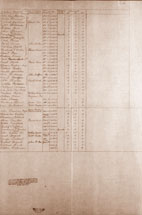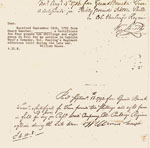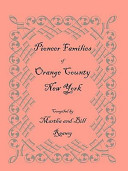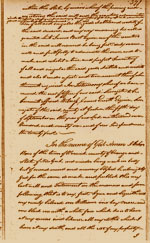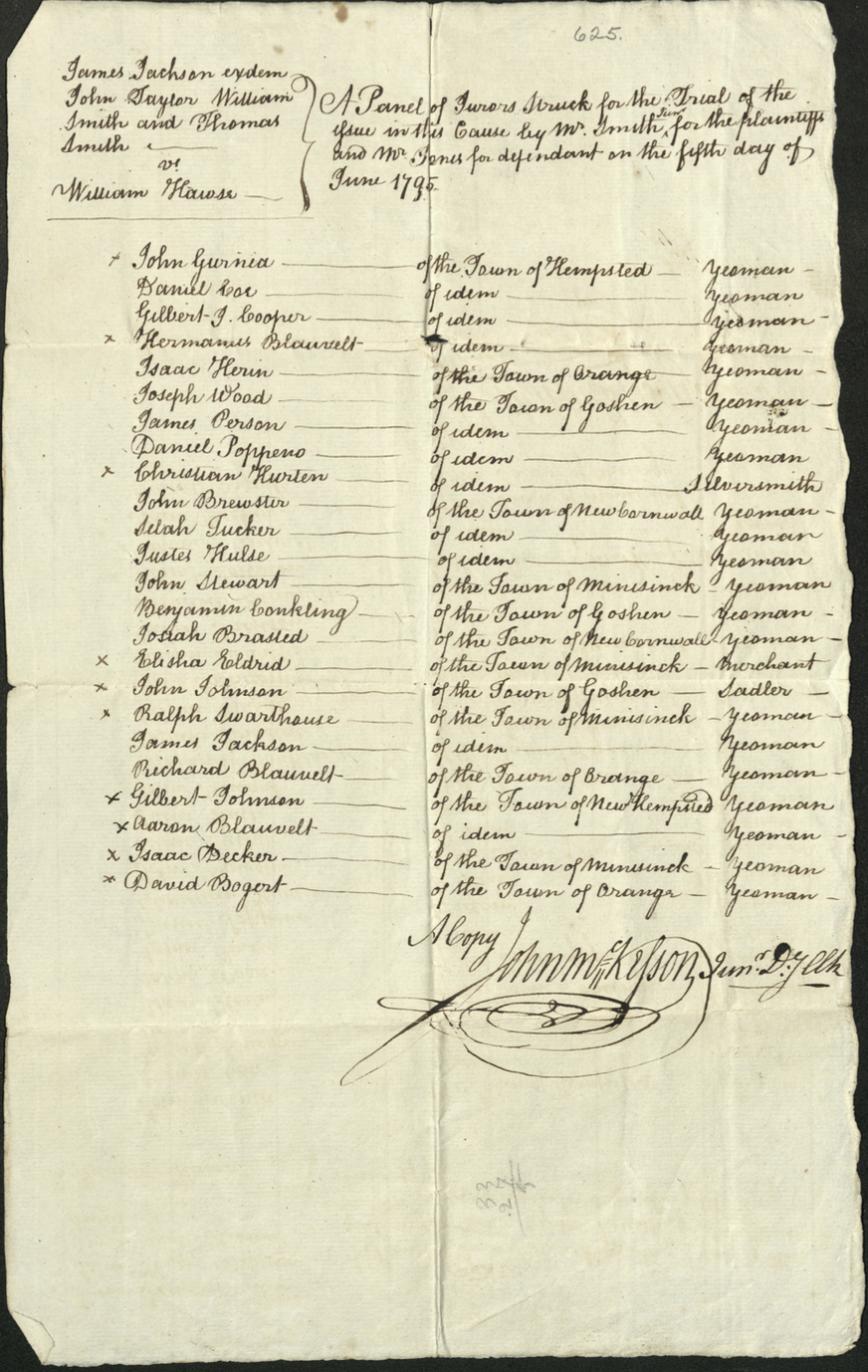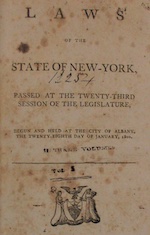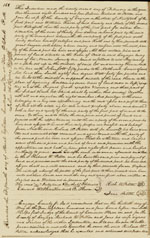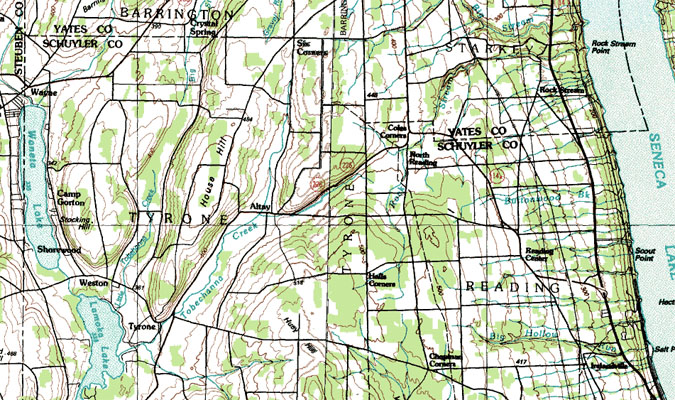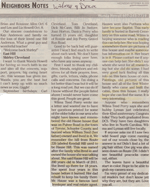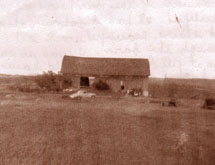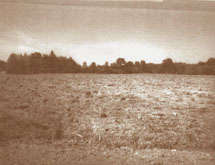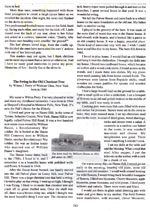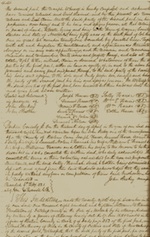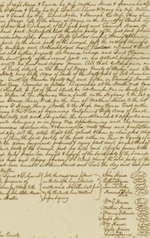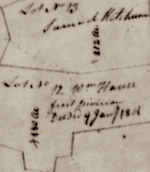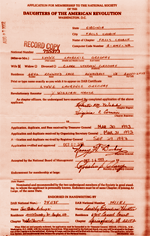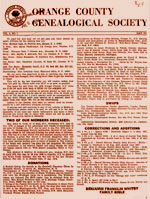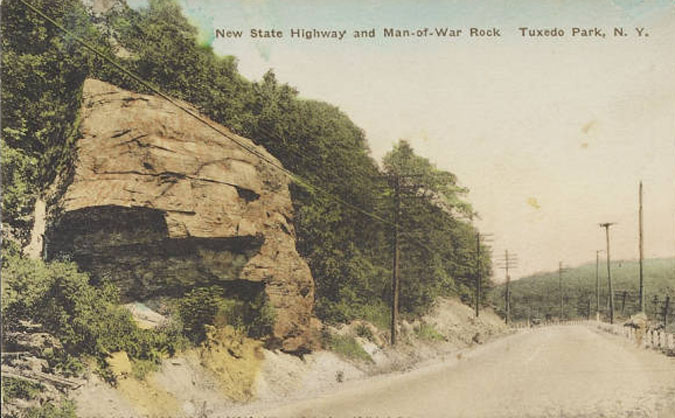|
"... We, the freemen, freeholders, and inhabitants of Haverstraw, being greatly alarmed at the avowed design of the Ministry to raise a revenue in America, and shocked by the bloody scenes now acting in the Massachusetts Bay, do, in the most solemn manner, resolve never to become slaves ; and do associate under all the ties of religion, honor, and love to our country, to adopt and endeavor to carry into execution whatever measures may be recommended by the Continental Congress..."
—Petition to King George III, signed by William Hause, July 17, 1775.
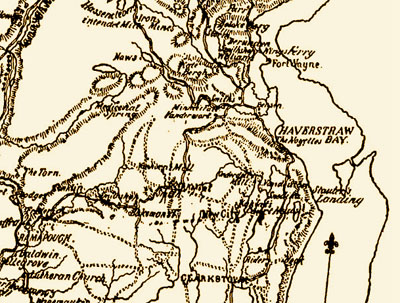
The Hause ("Haws") family property between Haverstraw and Warwick, shown in a 1779 map created for General Washington during the Revolution. (Click to enlarge.)
|
|
WILLIAM HAUSE (24 Feb 1750/51—20 May 1818), our oldest confirmed ancestor, is not the shadowy figure that he was just a few years ago—thanks to the hard work of many family genealogists. We may never know exactly what William looked like (unless a description can be found on some as-yet undiscovered muster roll), but we do know the places he lived (we have deeds, property sales, and even a beautiful piece of land that was named after him in Western New York, called "Hause Hill"); According to accounts by his grandchildren, he was "one of the 'boys'" who was known for "lighting cigars with V's." (Which would be revealing, if we only knew what "lighting cigars with V's" meant.) We know that he lived through a dangerous, turbulent, heroic time, and that he toiled and prospered right along with the fledgling country he fought to create; Perhaps most importantly—we know that he left us with a proud heritage. We even know how he signed his name:

|
| Personal Information |
Baptism Record |
| Name: |
|
Haas, Willem |
| Birth Date: |
|
24 Feb 1750 |
| Father: |
|
Johannes Haas |
| Mother: |
|
Sarah |
| Baptism Date: |
|
2 Jun 1751 |
| Place: |
|
All Boroughs, NY |
| Witnesses: |
|
David Roeter and Anna Huett |
|
|
|
SOURCE INFORMATION: Dutch Reformed Church Records from New York and New Jersey. Holland Society of New York, New York.
|
|
Most family genealogists agree that he was born WILHELM or WILLEM HAUSE, on 24 Feb 1750/51 to "Johannes Haas and wife Sarah," as listed in the New York City Lutheran Church books. He grew up on the frontier in the Ramapos, a forested chain of the Appalachian mountains in northeastern New Jersey and southeastern New York, between the towns of Warwick and Haverstraw in Orange County, New York, eventually starting a family in what is now called Tuxedo. The earliest occupants of the area were the Lenni-Lenape Indians, who named the largest lake in the area "Tucseto," meaning either "place of the bear" or "clear flowing water."
Orange County was an important trade route in New York. One of the first twelve counties established by the Province of New York in 1683, Orange was directly north of the New Jersey-New York border, west of the Hudson River, east of the Delaware River and northwest of New York City, and the Hause family lived right on the main passway, called the "Jersey Gore" (now called the Orange Turnpike). According to the research of Charles Hause (a descendant of William's through his son, William Jr.), William's father John was the "roadmaster" of this pass between New York and New Jersey, which went right through his property. The story goes that the road around that area was treacherous, and there was only room for one horse to pass through at a time. Outlaws would stand on top of the rocks, and jump down to rob travelers as they rode through.
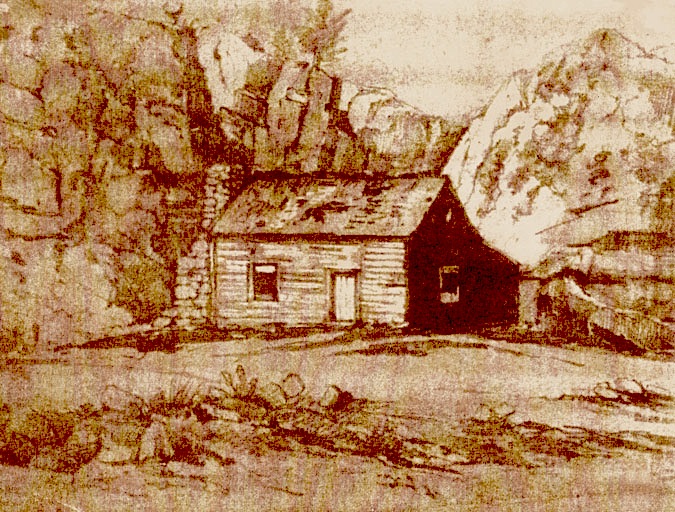
Artwork featuring a cabin from the early 1800's, in front of the Man-of-War rock in Tuxedo, where the Hause family lived, according to land deeds. It hangs in the Tuxedo Park Library.
|
Relations between the Thirteen Colonies and England slowly but steadily worsened after the end of the French and Indian War in 1763, which had plunged the British government deep into debt. In response, Parliament enacted a series of measures, such as the Stamp Act of 1765 and the Townshend Acts of 1767, to increase tax revenue from the colonies. The British government viewed these measures as legitimate means of having the colonies pay their fair share of the costs of maintaining the British Empire. But other measures such as the New York Restraining Act of 1767, enacted to punish the province for failing to comply with the Quartering Act, requiring local governments to provide the British soldiers with housing and food, were seen as punitive and unnecessary. Although protests led to the repeal of the Stamp and Townshend Acts, Parliament adhered to the position that it had the right to legislate for the colonies "in all cases whatsoever" in the Declaratory Act of 1766, prompting the occupation of Boston by British troops in 1767.
So how did William Hause respond to the oppressive actions of the British government? He may not have even noticed. He had fallen in love with MARTHA WOOD (4 May 1753 - 8 Sep 1822), and they were married in 1770. Martha's father, Jonathan Wood, was from the Kakiat Patent on the New York/New Jersey border, near Haverstraw and Ramapo, and was the constable of Haverstraw Precinct from 1753 to 1755 (comprised of the current towns of Ramapo, Clarkstown, Stony Point and Haverstraw). Martha's mother, JOHANNA CROMPTON (b. 06 Oct 1725), had moved with her family from Connecticut with a group of Baptists seeking religious tolerance. They resided in an area of Haverstraw settled by Quaker families, called Ladentown (Source: The New York Genealogical and Biographical Record, Volume 125, page 178). This was not a militant family looking to overthrow a government, and William was too preoccupied with personal relations to care about political ones.
That all changed with the "Boston Massacre," known as the "Incident on King Street" by the British, was an incident on March 5, 1770, in which British Army soldiers shot and killed several people while under attack by a mob. A trial was held, and John Adams served as the lawyer for the soldiers, calling the mob "a motley rabble of saucy boys, negroes, and molattoes, Irish teagues and outlandish jack tarrs." The jury agreed with Adams and acquitted six of the soldiers, while two were found guilty of manslaughter because they had fired directly into the crowd. The aftermath of these events turned colonial sentiment against King George III and British Parliamentary authority. Samuel Adams and other Patriots created an annual "Massacre Day" to protest against British rule, leading to the Boston Tea Party on 16 Dec 1773.
Despite all of their differences, everybody in Colonial America could agree on one thing: they all hated taxes! The problem was, nobody could agree on the best way to combat their rising tariff woes. Some people believed independence from Britain was the only answer. But other people only protested "taxation without representation," believing that if they were to be taxed by Britain, then they deserved a representative in Parliament. The British, however, disagreed with both views, believing the Colonies were not part of Britain—they were a possessions of Britain, existing solely for profit. And the King's rebuke gave the rebels just enough of a majority to start a war.
Meanwhile, William and Martha were starting a family, but what small comforts and luxuries that they enjoyed in a primitive frontier log farmhouse were disappearing. Because of British taxation, a "Non Importation Pledge" was implemented in 1774, meaning all British imports were boycotted and whatever the family couldn't produce on the farm had to be purchased from local makers, often of more primitive quality. After the Boston Tea Party, Martha even had to give up her beloved imported British tea and make her own from native plant substitutes, like sage, currant, strawberry, loosestrife, or plaintain leaves. The result was called "Liberty Tea." (Hopefully real liberty would taste better than the tea.)
The First Continental Congress, which was comprised of delegates from the colonies, met in 1774 in reaction to the these hostilities, and on 5 Sep 1774, it endorsed the formation of 'Regional Committees' to help ensure the rights and liberties of American Colonists. These committees gradually assumed control of the civil and military affairs, and became the de-facto government. They began organizing militias and stockpiling weapons. As they became more powerful, there was less need for protection from Britain.
The next mention that we find of William during this time is on a petition that he signed in the Haverstraw precinct on July 17, 1775. The petition, "General Association adopted by freemen, freeholders and inhabitants of the city and county of New York on April 29, 1775, and transmitted for signing to all the counties of the province," takes King George III to task for the conduct of his soldiers in Massachusetts, where the first shots of the Revolution had been fired at Lexington and Concord... but it carefully avoids a call to arms:
| "Persuaded that the salvation of the rights and liberties of America depends, under God, on the firm union of its inhabitants in a vigorous prosecution of the measures necessary for its safety, and convinced of the necessity of preventing the anarchy and confusion which attend the dissolution of the powers of the government, we, the freemen, freeholders, and inhabitants of Haverstraw, being greatly alarmed at the avowed design of the Ministry to raise a revenue in America, and shocked by the bloody scenes now acting in the Massachusetts Bay, do, in the most solemn manner, resolve never to become slaves ; and do associate under all the ties of religion, honor, and love to our country, to adopt and endeavor to carry into execution whatever measures may be recommended by the Continental Congress, or resolved upon by our Provincial Convention, for the purpose of preserving our Constitution, and opposing the execution of the several arbitrary and oppressive acts of the British Parliament until a reconciliation between Great Britain and America, on constitutional principles (which we most ardently desire), can be obtained ; and that we will in all things follow the advice of our general committee respecting the purposes aforesaid, the preservation of peace and good order, and the safety of individuals and private property."
|
"No one slept safely in his bed. Many families hid themselves at night in barns, wheat-ricks, corn-cribs, and stacks of hay; and on each returning day, blessed their good fortune that their houses had escaped the flames."
—Historian Joshua Hett Smith of Haverstraw, in a contemporary account of the plight of its terrified inhabitants in the years leading up to the Revolution.
 (Drawing by John W. Thomason, Jr.) (Drawing by John W. Thomason, Jr.)
|
The American Revolution is widely misrepresented today. This was not simply a war in which a foreign power was forcibly controlling a completely hostile land. This was a civil war—brother against brother. Many people in the colonies were actually Loyalists, who felt they were better off under England's protection against the French and Indians (and furthermore, much better off than they had been back in their former countries). The number of Loyalists in each colony varied. Recent estimates suggest that half the population of New York was Loyalist; it had an aristocratic culture and was occupied throughout the Revolution by the British. And there were Hause and Wood family members on both sides of the conflict.
But our family wasn't alone: Benjamin Franklin's own son, William (then the governor of New Jersey, mentioned in the previous chapter), remained loyal to the British—even after torture and imprisonment by the rebels, who were led by dear old dad.
John Adams (later a United States President) estimated that a full third of the population were Loyalists (or 'Tories'), another third were revolutionaries ('Whigs'), and the final third were on the fence. Furthermore, the Colonists appeared to have little chance to win. They possessed no trained armed forces, no established central government, no financial reserves and no industry to supply their effort. North America had been settled to export raw materials to England's factories, not create finished goods for themselves. So there were no manufacturing facilities to produce arms and support a war.
In fact, it was a miracle that the various Colonies could unify in the common purpose of a revolution at all. They were all separated by dense forests, rivers, and dangerous Indian land. Even when there were common borders, they would feud over the boundary lines to the point of war, then not allow their roads to connect. Ideologically the various Colonial regions were separated by issues of slavery, race and religion. For instance, the Puritans of New England hated the Anglicans of the south. And all that those two groups could agree on was that they hated the Catholics, Quakers and Jews. The North and South had already divided on slavery: the southern colonies having built their economy on it, while the northern colonies had practically abolished it (in fact, one of the victims of the Boston Massacre, ground zero for the revolution, was Crispus Attucks, a freed slave).
Still, hostilities between the King and the Colonies escalated to the point that a law was passed by the Continental Congress on 16 Sep 1776 providing for the enlistment of 88 battalions of men to carry on a war for independence. The response from the people of the Colonies to this measure was divisive, to say the least, and the opposing sides took on the name of English Parliamentary parties. The "Whigs" became the patriot side and the "Tories" became the Loyalists.
"In Consequence of your Excellys Desire to receive timely Information of every Mœnuver which the Enemy on Hudsons River may make, to distress the Inhabitants at this extreme Busy Season, we can inform your Excelly that this Morng between the Hours of 10 & 11, the whole Fleet consisting of 2 Men of War and 3 Tenders made Sail from Niac, and about 12 came into Haverstraw Bay ... If your Excellency can possibly spare a small Detachment from the continental Forces for a few Days, untill the Farmers can take in their Crops as it is now in the Height of their Harvest you will render us essential Service and a few Days now is of the utmost Consequence to them—When the Harvest is in we shall with the utmost Chearfullness lend every Assistance in our power to promote the common weal of the Community."
—Letter to General George Washington from the Orange County Committee of Safety, Haverstraw, July 16th 1776.
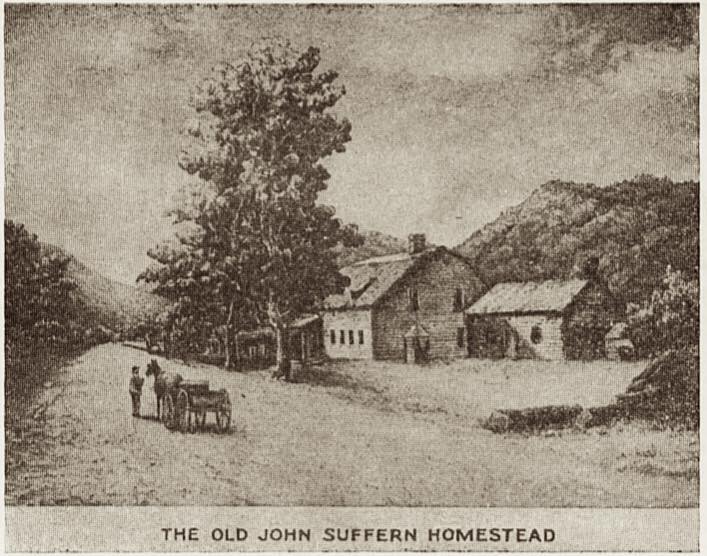
Suffern's Tavern, a noted hostelry of the Revolution in Rockland County. It served as the headquarters of General Washington, from July 15th to 20th, 1777. It was also the Headquarters of Colonel Aaron Burr, commanding the troops guarding the Ramapo Pass, where the Hause family lived. (Image appeared in South of the Mountains, Vol. 5 No. 1 January-March 1961.)
|
|
The Commander-in-Chief of the military, General Washington, had reservations about the use of partially trained militias, but Orange County raised troops and formed regiments, anyway. The Old Goshen Militia was split, and a new one formed in Warwick, with Captain John Hathorn—formerly the town's assessor and school teacher—as the leader. The volunteers were mainly men from farms between Warwick and Florida, with companies drawn from near Wickham Lake (where John lived in the 1775 census), the Ridge area, Sterling, and areas bordering New Jersey. Their task was primarily to keep the British from seizing area iron mines. (Many of the area's settlers were employed at the Sterling Iron Mine Works in neighboring Ringwood, New Jersey.)
William didn't join up to fight, despite signing the "General Association" petition in Haverstraw. However, being a roadmaster by way of the Ramapo Pass, it was his responsibility to keep the route clear for the Continental army while the British were invading the lower Hudson Valley. Military maps created during the Revolution that depict this region do not show the roadway, but several homesteads were established along the route during the 18th Century (the name "Haws" can be seen on the route in Washington's map, at the top of the page).
But William probably had trouble taking any side at the beginning of the conflict. He now had three children at home, and his wife, Martha, came from a line of Puritans and were pacifists—although one first cousin, Jonas Wood, Jr., of Warwick, became a notorious Loyalist who was nearly hanged for the murders of Joseph Westphal and Philip Swartout, Jr., in 1778, but escaped from his jail cell and fled to Canada.¹
So what caused William to finally join the Rebels and fight? One possible reason could have occurred at the battle of White Plains in 1776:
"John Hause and his brother Simon Hause, served as volunteers in the American Army, during the Revolution until the Battle of White Plains, in which he and his brother Simon, standing side by side, were shot by the enemy. They received a Soldier's Burial, the place of which is unknown. John Hause, who was killed at White Plains, had two children, John and Polly. John Hause's Widow, married a Benjamin Butler, and had six children. That part of Orange Co. where he died is now Rockland County, NY."
—Based on records copied from the Family Bible of Joseph Hause of Ovid, New York, during the 1800's (Bible now lost).
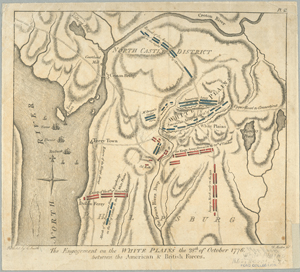
"The engagement on the White Plains, the 28th of October 1776 : between the American & British forces." Martin, D., Engraver; Charles Smith, Publisher [1796]; 19 x 22 cm. Location: Stephen A. Schwarzman Building; The Lionel Pincus and Princess Firyal Map Division, New York Public Library. (Click to enlarge.)
|
|
If this family legend is true, then John and Simon Hause were among the first to join the independence movement. They would've learned to fight the larger British forces with guerilla-style tactics learned from Native Americans, using their own rifles and attaching homemade bayonets. It was bloody, brutal combat that they signed up for—and they were killed on October 28, 1776, at the Battle of White Plains, where they faced General William Howe's British army, which was completing its capture of New York.²
General Washington and his army had been overmatched by British artillery, and had withdrawn to the high ground near the village of White Plains, taking many lives as they fell back through the forest, until the British caught up, with 14,000 troops, including Hessians who might even have been related. Cooper brought the militia there. Meanwhile, William's cousin, Andrew Secor, was fighting under General Green, and was shot in the thigh, with another bullet passing through his hat. John and Simon weren't so lucky. They were shot dead, side-by-side. (The Fifth Regiment, which included Orange County recruits, fought in the battle of White Plains. Its muster rolls feature the name of "Simon Hauss.")³
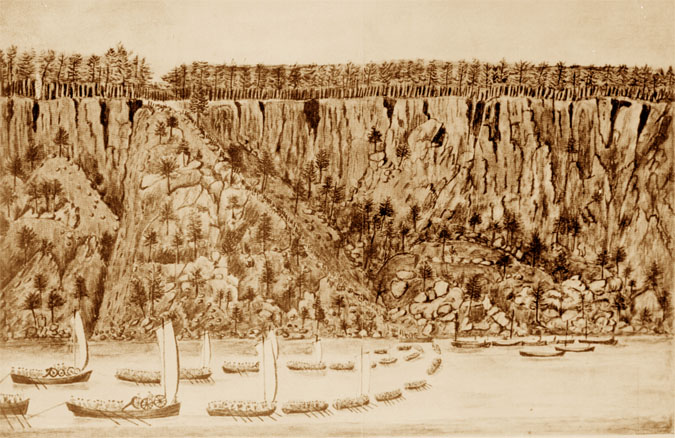
The landing of the British forces in the Jerseys on November 20, 1776, under the command of Rt. Hon. Lt. Gen. Earl Cornwallis. Watercolor by Thomas Davies, a British officer, 1776. (Click to enlarge.)
|
"The enemy are now extending their ravages into this state, and on Monday the 29th ulto. made their appearance at Tappan with a large body commanded by Cornwallis in person, and after butchering in a most inhuman manner a number of Light Horse, they turned their cruelties to women and old men, whom they treated with every kind of brutality their perfidiousness could invent... Knowing the small number of our whole force, we have every reason to expect we must, unless immediately relieved, fall a sacrifice to the enemy."
—Letter from local residents of Tappan to New York Governor George Clinton, pleading for state assistance.
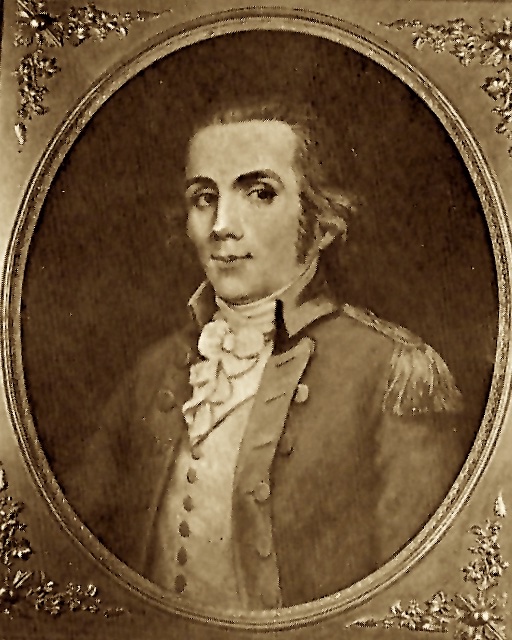
William's commander, Colonel Ann Hawkes Hay, also served as Quartermaster, paying a lot of soldiers out of his own pocket when the American economy couldn't afford it. Although he was a wealthy landowner in Jamaica before the war, Hay died in poverty in 1785. (Image: Haverstraw Brick Museum.)
|
|
Whether it was family deaths, patriotic fervor, or religious convictions that caused William to join the rebellion is only speculation, but we know that he joined the Orange County Militia in New York, serving out of Haverstraw with the Second Regiment under Colonel Ann Hawkes Hay (Hay, pictured at right, was named "Ann" for an aunt who left him her inheritance). Other family members in the militia were John, Uncle John Secor of Haverstraw (husband of William's aunt Catherine Hause), cousins Andrew, Benjamin, Daniel and Isaac Secor, and cousin John Conklin, related to William through his Aunt Sally Hause.
New York State was a principal battleground of the Revolutionary War. Approximately one-third of the skirmishes and engagements of the war were fought on New York soil. George Washington's headquarters were in Orange County for a time, and it's said that he even climbed the Ramapo Torne (near Ramapo hamlet) with a telescope to watch the movement of British ships off Sandy Hook in New Jersey. He then stationed troops at the mouth of Smith's Clove (now Monroe) near Ramapo to block potential British troop movements by land toward his headquarters in New Windsor. As for commanding the militia, Washington relied greatly on the help and friendship of Ann Hawkes Hay, whom Washington eventually appointed as his Quartermaster.
The New York militias were around long before the American Revolution, starting around 1691. They were a kind of standing home army, separate from the regular army, that met on training days to practice military maneuvers and gun handling. All able-bodied men between 16 and 60 were required to serve, keeping a musket, bullets and powder at the ready to repel an attack by the French or the Indians. They were mostly farmers and tradesmen who were unable to commit to service in the regular army because of family and/or financial reasons, but instead volunteered to serve their home colony, pledging to be ready to fight at a moment's notice. This was especially crucial where William lived on the Ramapo Pass, considered the weak spot in the defense.
"That pass is so exceedingly important that they should never be suffered to possesss it."
—George Washington, 30 Sep 1778 ("The Writings of George Washington," Vol. XII, p. 529)
|
| Book Information |
Image
|
|
| Title: |
|
Documents relative to the colonial history of the state of New- York |
| Volume: |
|
XV |
| Editor: |
|
Berthold Fernow |
| Publisher: |
|
Weed, Parsons & Co., Albany |
| Date: |
|
1853 |
| Page: |
|
390 |
|
|
|
|
SOURCE INFORMATION: Smithsonian Libraries, Call number 39088007725757. William appears twice in the Roster of State Troops on page 390, as "William Hause" (Cooper Regiment, Blauvelt Co.) and "William Haws" (Pawling Regiment, Wood Co.)
|
|
The old King's Highway would become the safest route for the rebellion past British-occupied New York City. As highwaymasters, William and his father were responsible for a key point in the pass, the only corridor through the surrounding mountains, making it an important route from troops and supplies. But as a member of the Orange County Militia, it was also William's duty to take arms at a moment's notice whenever the British threatened any section of the western shore of the Hudson River from Stony Point to Fort Lee. The men in this militia were not trained soldiers, but poor farmers and hired hands, dropping their pitchforks and grabbing a rifle whenever the British, Indians and/or Tories attacked in the area covering New York and New Jersey. Their job was to keep the British from controlling the Hudson River—a vital military supply line during the American Revolution. In 1775, Haverstraw residents, largely local farmers, joined forces with the Orange County Militia and formed the Shore Guard to watch the Hudson River. Their early warning system to spot approaching British ships was made possible by signal fires visible for many miles on top of High Tor and West Hook Mountains. Colonel Hay instructed the Shore Guard to post sentries every day after 4pm, and to remain on post until relieved. On July 15, 1776, the Shore Guard was put to the test when the British attempted to land in Haverstraw. Fortunately, the British were repelled—saving a key munitions store in Haverstraw. Then in 1777, the British landed at Peekskill and the Shore Guard was again enlisted to protect the munitions on the western shore by Colonel Hay. During the war, the British also attempted landings at Piermont, Rockland Lake, and Haverstraw—but occasionally succeeded: Cattle and provisions were taken, homes were burned—including Hay's home—and lives were lost. Still, the Militia and Shore Guard kept the British from ever gaining a foothold on the shores of the Hudson. If they had failed, we would probably all be British citizens today.
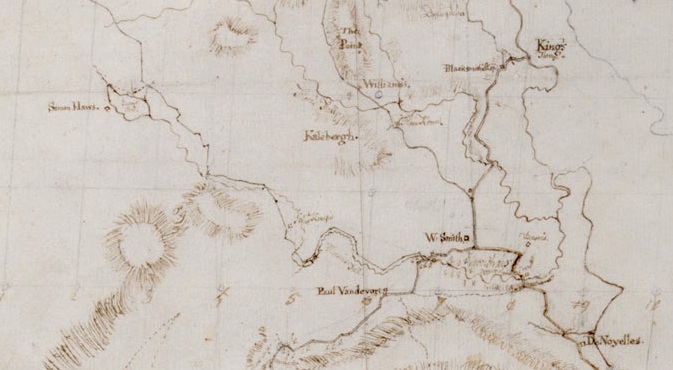
"From Newborough (Newburgh) to Fort Lee, No. 36" by Robert Erskine, Washington's map maker during the war. This military topographic map covers Orange and Rockland Counties in New York and Bergen, Passaic, Morris and Essex Counties in New Jersey. This section shows the residence of Simon Haws, in the upper left. On 28 Jul 1779, Washington ordered that the wilderness country should be "well explored" up to the isolated mountain home of Simon Haws (Washington spelled it "House," the bastard!) at the Beaver Pond (now Lake Welch). The Simon Haws house stood in the 19th-century hamlet of Sandyfield, at the junction of Route 210 and Johnsontown Road in the Palisades Interstate Park. (SOURCE: "Corridor Through the Mountains" by Richard J. Koke, Orange County Historical Society, published 2020, page 100.) Collection of the New York Historical Society.
|
"If the enemy persist in their plan of subjugating these States to the yoke of Great Britain, they must, in proportion to their knowledge of the country, be more and more convinced of the necessity of their becoming masters of the Hudson River, which will give them the entire command of the water communications with the Indian nations, effectually prevent all intercourse between the eastern and southern confederates, divide our strength, and enfeeble every effort for our common preservation and security."
—Report submitted by the Provincial Congress of New York to the Continental Congress in 1775.
 The Hudson River was of vital importance to both sides during the conflict. During the American Revolution, Rockland became an important crossroads—a crucial link between the Northern and Southern colonies. There were American fortifications at Sidman's Fort at Suffern, a blockhouse at Palisades, and larger forts at Stony Point, Bear Mountain and Fort Montgomery. Entire armies and vital supplies passed through Rockland on their way to war. The British hoped to control the river and divide the Colonies, as well as speed the communication between their armies in Canada and lower New York. So the rebel militia set up obstructions in the water, including "fire-ships," booms, and cheveaux-de-frise (made by sinking cribs of timber across the channel), to impede British ships. Large iron chains, almost two thousand feet across, were stretched underwater at several points that the rebels could pull tight. But the British eventually smashed their way through all of the obstructions, and it was up to the militia to halt their progress. The Hudson River was of vital importance to both sides during the conflict. During the American Revolution, Rockland became an important crossroads—a crucial link between the Northern and Southern colonies. There were American fortifications at Sidman's Fort at Suffern, a blockhouse at Palisades, and larger forts at Stony Point, Bear Mountain and Fort Montgomery. Entire armies and vital supplies passed through Rockland on their way to war. The British hoped to control the river and divide the Colonies, as well as speed the communication between their armies in Canada and lower New York. So the rebel militia set up obstructions in the water, including "fire-ships," booms, and cheveaux-de-frise (made by sinking cribs of timber across the channel), to impede British ships. Large iron chains, almost two thousand feet across, were stretched underwater at several points that the rebels could pull tight. But the British eventually smashed their way through all of the obstructions, and it was up to the militia to halt their progress.
The Orange County militia did other things to even their odds against a well-trained British army: They used the countryside to conduct guerilla warfare, with techniques that they learned from the Indians. They hid behind trees and rocks, picking off the British soldiers who marched in formation down country lanes. They chopped down trees to impede the progress of the British army, and turned the roadways into swamps. They also destroyed crops and drove off cattle to deny food to the redcoats—which probably left farmers wondering who the real enemy was. (But when Butler's Rangers burned the village, or British troops started cutting off the limbs and heads of those who didn't swear allegiance to the King, the difference became pretty clear.) Hay's Regiment fought in the Battle of Stony Point, then acted as guards to the British prisoners. They also guarded the lines at Tappan and Nyack.
For this duty, William received an initial bounty of twenty-five dollars on his passing muster, and then 10 shillings per week in lieu of rations. Eventually each militia man received a salary of 53 shillings, 4d. per month, along with one blanket, one Regimental coat (militiamen did not have standardized uniforms), and ten shillings for the use of his arms (including a flintlock or rifle, sword, tomahawk, priming brush and pick, pouch or cartridge box, gun flints, knapsack, canteen or wooden bottle, and a jack knife)... not that he actually got paid all of that, but it's what he was promised at the outset.
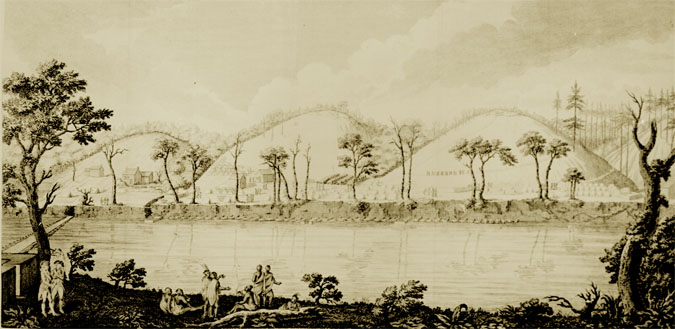
The British invade the Hudson: This illustration shows the left bank of the Hudson River 3 miles above Still Water, upon which the army under the command of Lieutenant General Burgoyne took post on Sept. 20, 1777. Engraving by Barlow; published by William Lane, London, 1789. (Click to enlarge.)
|
"... This is a most villainous country, Rough, Rocky and a bad climate. Rattle snakes & Robbers are plenty. It was an infringement on the rights of the wild Beasts for man ever to enter this Clove, it ought to have remained as Nature certainly intended for it for the sole use of snakes, adders, & Beasts of prey."
—New England officer in Ramapo, 1779. (Source: "Corridor Through the Mountains" by Richard J. Koke, Orange County Historical Society.)
|
| Muster Roll |
Image
|
|
| Name: |
|
William Hause |
| Military Organization: |
|
Cooper's Regiment |
| National Number: |
|
M246 |
| Date Range: |
|
(Blank) |
| State: |
|
New York |
| Folder: |
|
91 |
| Page: |
|
7 |
| Service Record (M881): |
|
Page 1
Page 2 |
|
|
|
|
SOURCE INFORMATION: National Archives. Personnel, pay, and supply records of American Army units in the Revolutionary War, '75-'85.
|
|
Hay's Regiment of Orange County Militia served under Col. James Clinton in the campaign into Canada, mustering 4 Aug 1775. They mustered again in November, 1776, for Colonel Dubois' Fifth Regiment, and served with distinction at the battles of Fort Montgomery and Fort Clinton. Hay's men were also called on different alarms from April 4, 1778 to August 9, 1780 in lower New York State and New Jersey. One muster roll with William from this period is at right, under Cooper's Regiment of Levies. These "levies" were men selected from the ranks of the general militia for additional training, then used to fill in the ranks of regular troops or as independent units, serving for a period of eight months or less, and were posted at outlying blockhouses and forts.
William probably used a hunting musket in battle (Hay complained to his superiors that only half of his men were adequately armed, so the others had to use their own weapons). The most common rifle in the militia was the smoothbore flintlock, of a large caliber, .62 to .75 inch bore (equal to 16 to 11 gauge shotguns). It was accurate enough when sneaking up close on deer or wild turkey, but it had no rifling in the barrel, so the ball might come out spinning like a screw ball, to any side. After 50 yards it was very hard for a soldier to deliberately hit a man sized target, so the rebels formed into units, two or three ranks (lines) deep, shoulder to shoulder. Then they fired volleys in unison, sending a mass of balls toward the approaching enemy, at least some of which they figured would hit their targets. Muskets could be fired as fast as every 15 seconds, which is a long time when you have a line of British soldiers charging at you with bayonets.
It would be nice to think that William could relax at his home between battles, but area where he lived was a flashpoint of conflict, split between Loyalists and Tories. The region would be terrorized by a group of Tories known as the "Cowboys." Their leader was notorious Loyalist guerrilla Claudius Smith. A wanted poster from the time described him this way: "COWBOY OF THE RAMAPOS—TORY LOYALIST TO THE CROWN, a fierce looking man nearly 7 ft. tall, wearing a suit of rich broadcloth adorned with silver buttons Notorious leader of a lawless band of men who've been terrorizing the good citizens of Orange County." Muster rolls actually list Claudius at about 5'9", but his infamy garnered him another 15 inches. New York Governor George Clinton posted a reward of $1,200 for Smith's arrest. He was captured and hanged on January 22, 1779, in the town of Goshen. Because his mother reportedly warned him that he would "die with his boots on," Smith removed his footwear before he was hanged, just to prove her wrong. Legend has it that his skull was filled with mortar and included in the edifice of the Goshen Court House. Two of Smith's three sons belonged to his gang—one was hanged with his father; the other, named Richard, took over the gang and earned himself the name of "Black Dick." Weirder yet, Claudius's brother, David Smith, Jr., fought alongside William under Colonel Ann Hawkes Hay!
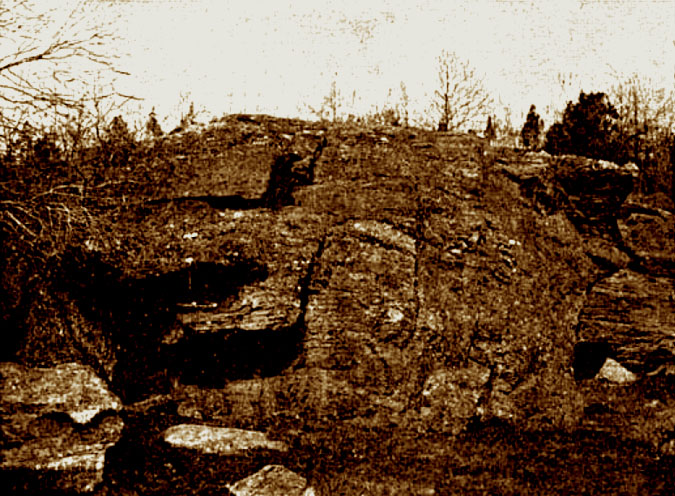
A 19th Century photograph of the Man of War rock near Ramapo, which protected the hideout of outlaw Claudius Smith. (SOURCE: "The Home-Maker: an illustrated monthly magazine, edited by Marion Harland: Volume 4, April to September, 1890," by Jane Cunningham Crol) A wanted poster from the time read: "TRAVELLERS BEWARE: The Wild, 'Tory Infested Clove', The Ramapo Valley, a 16 mile stretch of main road along which pass all communications between Canada & N.Y.C. has placed the Smith Hideout somewhere in the mountains east of Tuxedo along this route. Consistent reports of travellers being detained at pistol point & looted of all valuable by these hoodlums is common throughout this region."
|
"Pawling ... served as colonel of a regiment of Swiss raised to protect the New York frontier."
—History of Rensselaer Co., New York, by Nathaniel Bartlett Sylvester, published in 1880.
|
| Signed Certificate |
Image
|
|
| Name: |
|
William Hause |
| Military Organization: |
|
Pawling's Regiment |
| Company: |
|
Wood's |
| Date: |
|
18 Sep 1792 |
| State: |
|
New York |
|
|
|
|
SOURCE INFORMATION: Steuben County Historical Society: Magee House, 1 Cohocton Street, Bath, NY (Twila O'Dell, historian); Telephone: 607-664-2199
|
|
William was also recruited to fight in Pawling's Levies. Levies were short-term units drawn from the militia, generally either to bolster understrength continental ("regular") regiments, or to do duty on the New York frontier. The leader of William's regiment, Colonel Albert Pawling, was a fiery, independent character. According to the History of Rensselaer Co., New York by Nathaniel Bartlett Sylvester, published in 1880, Pawling resigned from Washington's army as a major, despite a letter from Washington himself asking him to remain, then "served as colonel of a regiment of Swiss raised to protect the New York frontier." In the book New York in the Revolution as Colony and State, William is actually listed in the company's roster twice, with his surname spelled both "Haws" and "House" (page 84). It probably wasn't coincidental that he was in "Wood's Company," the surname of his in-laws.⁴
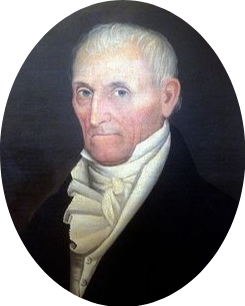
|
Colonel Pawling's Levies manned forts from 1779 to 1781 along the frontiers of Ulster, Orange, and Westchester Counties.⁵ These forts were block houses, enclosed by a breastwork capable of holding a hundred defenders, and could protect up to 200 people altogether. They also erected beacons along the coast, and when a huge red-and-white striped flag was hung by day, or a bonfire lit at night by a sentry, that meant the British were coming up the river. William would then have to grab his musket and rendezvous with the rest of his regiment. Occasionally he would have been annexed to Continental battalions at Poenpeck, to scout or fight.
On the frontier, the chief task of the levies was to stop raids carried out by the Indian forces and Loyalists, often led by a British officer. Two important battles took place in William's area: the capture by the British of Fort Clinton at Bear Mountain in 1777 and the victorious attack on the British fort at Stony Point in 1779. There were several small battles in Rockland County, as well, when British landing parties attempted to come ashore at Nyack and Haverstraw—most notably on July 13, 1776, when an attempted British landing was repulsed by the militia.
"DEAR SIR: Yesterday three of the enemy's ships-of-war, and some other vessels, passed our forts at King's Bridge, and are now anchored off Nyack. My regiment consists only of three hundred men, and very near one half of them are without arms. I should be very glad to know what I am to do, and where I must apply for a reinforcement in case they should attempt a landing on the west side of Hudson's river. We are destitute of provisions for the guards I now have out, and I must therefore request that the Convention will be so kind as to send me per the bearer a sum of money to purchase the provisions. I am, dear sir, your most obedient servant, A. HAWKES HAY."
—Col. Ann Hawkes Hay to Col. Peter R. Livingston, President of the Convention of the State of New-York, at Fishkill. (Haverstraw, October 10, 1776).
|
| Book Information |
Image
|
|
|
| Name: |
|
Historical Record of Rockland County |
| Editor: |
|
Arthur S, Thompkins |
| Year: |
|
1902 |
| Publisher: |
|
Van Deusen & Joyce, Nyack, New York |
| William Hause: |
|
Page 162 |
|
|
|
The levies in Orange County were undermanned, under-fed, and worst of all, under-armed, and Hay's plea for a better gameplan, reprinted above, was finally answered by Washington with an order for a suicide mission: He sent them into the battle of Stony Point on July 15, 1779 against cannon and vastly superior firepower, armed with only fixed bayonets.
The mission was for General "Mad" Anthony Wayne (yes, that was his actual nickname) and about 1,350 carefully selected soldiers, including much of the 2nd Regiment, to perform a night assault against the British stronghold, wearing pieces of white paper pinned to their hats so they could tell each other apart in the darkness. Preparing for the worst, Wayne wrote his will before the battle. But his men forced the surprised British garrison to surrender in less than an hour, took over 500 prisoners (along with supplies and armaments), and destroyed the fort on their way out. General Wayne was awarded a medal by congress, one of the few issued during the Revolution.
We don't know if William fought in that battle, as he never recorded his experiences in the war. But his cousins, Andrew and Benjamin Secor, described their exploits with the 2nd Regiment in their pension applications about 50 years later:
|
| Personal Information |
War Record Image
|
|
|
| Name: |
|
Andrew Secor |
| Township: |
|
Haverstraw |
| County: |
|
Orange |
| State: |
|
New York |
| Year: |
|
09/04/1832 |
| Number: |
|
S 15232 |
|
|
|
|
| Personal Information |
War Record Image
|
|
|
| Name: |
|
Benjamin Secor |
| Township: |
|
Haverstraw |
| County: |
|
Orange |
| State: |
|
New York |
| Year: |
|
1/02/1834 |
| Number: |
|
S 2297 |
|
|
|
SOURCE INFORMATION: National Archives Case Files of Pension and Bounty-Land Warrant Applications Based on Revolutionary War Service, compiled ca. 1800 - ca. 1912.
|
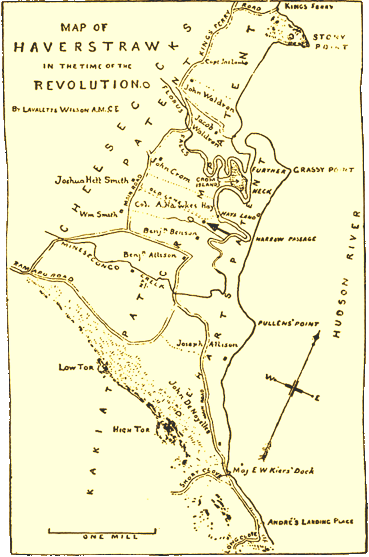 Things worked out well for General Wayne, but not for Colonel Hay, whose family was even more ripped apart by the war than our own. The uncle of his wife, Martha Smith, was a Loyalist who became the chief justice of Canada; Another uncle was intimately acquainted with General Benedict Arnold and Major John André, adjutant-general of the British Army. André was negotiating with Arnold, who had fallen for the 18 year-old daughter of a Loyalist and was switching sides. Arnold offered up West Point to the British for $20,000, by weakening the chain obstruction in the Hudson. But André was caught while stranded onshore along the Hudson when his ship, the HMS Vulture, had to retreat due to attacks by the Colonists. He was hanged while Arnold escaped and officially became a brigadier general for the British. Things worked out well for General Wayne, but not for Colonel Hay, whose family was even more ripped apart by the war than our own. The uncle of his wife, Martha Smith, was a Loyalist who became the chief justice of Canada; Another uncle was intimately acquainted with General Benedict Arnold and Major John André, adjutant-general of the British Army. André was negotiating with Arnold, who had fallen for the 18 year-old daughter of a Loyalist and was switching sides. Arnold offered up West Point to the British for $20,000, by weakening the chain obstruction in the Hudson. But André was caught while stranded onshore along the Hudson when his ship, the HMS Vulture, had to retreat due to attacks by the Colonists. He was hanged while Arnold escaped and officially became a brigadier general for the British.
With friends like those two, Hay's uncle in-law was suspected of treachery as well, and finally fled to England.
Ironically, while Hay's Loyalist in-laws were being extradited and having their homes burned in Haverstraw, their sympathizers were confiscating all of Hay's property in Jamaica, and burning his home in Orange County, as well, which would leave him destitute after the war. In a letter written from West Point on August 2, 1779, Gen. Washington expressed his distress to Hay about the "repeated depredations of the enemy on your property."
"The day before he was to be hung, Jonas, by some super-human effort managed to escape from prison and (so one record says) with others set off across 300 miles of unbroken forest to safety in the British stronghold of Niagara. In his own words he was "Four weeks in distress in the bush". From Fort Niagara he was sent by boat down Lake Ontario and the St. Lawrence to Montreal were he arrived in 1780."
—Recounting the escape of Loyalist Jonas Wood, the cousin of William Hause's wife, sentenced to hang for murder during raids over the course of the war (Source: "Jonas Wood UEL," by Hoople, Elizabeth. Glengarry Historical Society, Wood Research Team, 1984. Stormont, Dundas and Glengarry, Ont. 33 pages).
|
| Personal Information |
Tax List Image
|
|
| Name: |
|
Hawes, Wm. |
| Precinct: |
|
Goshen (Smith's Clove to Warwick) |
| County: |
|
Orange |
| State: |
|
New York |
| Year: |
|
1779 |
| Month: |
|
April |
| Page: |
|
16 |
| Real Estate: |
|
0/0 |
| Personal: |
|
5/12/0 |
|
|
|
|
SOURCE INFORMATION: New York State Archives, New York State Education Department, Cultural Education Center, Albany, NY 12230; Series A3210, Accounts and Tax Assessment Lists, 1721-1779, 1779-1788.
|
|
Unlike Colonel Hay, William got through the war fairly unscathed. He had his own family scandals (cousin Jonas Wood of Warwick, a Loyalist, was nearly hanged for the murders of Joseph Westphal and Philip Swartout Jr., but escaped and fled to Canada). But William served his time in the military and paid his taxes. In April of 1779 a Land and Personal Tax to fund the war was assessed for the precinct of Goshen, encompassing the area from Smith's Clove (the present-day Village of Monroe) to Warwick. William had no real estate but had a personal value of 5 pounds 12 shilling at the time, so either he was renting or living with his parents. (William does not appear on the 2nd Assessment done later on in October. This may indicate when he was in the Militia between April and October 1779.)
That year was a brutal one in the Warwick area. Beyond the murder trial and escape of Jonas Wood, Loyalist raider Claudius Smith was executed in Goshen in January; then in July, Mohawk Chief Joseph Brant attacked and burned much of the hamlet of Minisink. The Orange County Militia, despite numerous desertions, fought Brant's forces on July 22nd in the Battle of Minisink, and suffered heavy losses. A blockhouse was then built in Warwick to protect the residents from Indian raids.
William survived those attacks and many other brutal, terrifying events over the course of the eight-year war, until British and American negotiators in Paris signed preliminary peace terms in Paris late in November of 1782. On 3 Sep 1783, Great Britain formally recognized the independence of the United States in the Treaty of Paris. The last British troops finally departed New York City on 25 Nov 1783, marking the end of British rule in the new United States.
William and Martha witnessed the birth of a new nation, as well as the birth of ELEVEN MORE KIDS—several during the war:
CHILDREN OF WILLIAM E. HAUSE AND MARTHA WOOD
|
|
JOHN HAUSE was born on 15 September 1773 in Rockland County, New York. On 6 Nov 1796, John married ESTHER KETCHAM (b. September 5, 1779) and they resided at Hause Point on the western shore of Cayuga Lake, Seneca County, New York. They had the following children: Delebar (1797-1868), Charles (1799-1885), Electa Ann (1801-1869), Augustus (1804-1875), Azubah (1806-1821), Belinda (1808-1873), Alanson (1810-1880), John II (1812-1881), Caroline (1814-1816), Loisa (1816-1816), Fannie Jane (1817-1838), Louisa M. (1819-1902) and Caroline Louise Hause (1821-1905). He died on 17 Jan 1844 and is buried at the Hause Point Cemetery (Canoga Cemetery) in Seneca Falls, Seneca County, New York (Section 5 Plot 72).
|
|
JOHNATHAN HAUSE was born on 8 April 1775 in Orange County, New York. He never married, and died in 1802 in Jamaica, Long Island, New York.
|
|
JOHANNA "HANNAH" HAUSE was born on 17 February 1776. She married Michael Weymer (b. 1771 in Ramapo) around 1800 (a Weymer family tree lists her as "Hannah House"), and they purchased her father's land in Ramapo (click on image at right to read the deed), as William and the rest of the Hause family moved to western New York. They may have had at least two sons (unidentified), then Michael probably died before 1810, as only his "heirs" are mentioned in his father's 1810 will, and Hannah is head of the household in that year's Federal Census, in Monroe, Orange, New York. She may then have married Samuel Clark on 8 Dec 1811 in Kakiat, Rockland, New York (SOURCE: Dutch Reformed Church Records from New York and New Jersey. Holland Society of New York, New York, New York).
|
|
SARAH J. HAUSE was born on 7 September 1777 in Orange County, New York. Sarah married (1) Samuel Johnson (b. 1774) then (2) William E. Harris (1758 - 1836). He was a private in the New Jersey Militia, and received an annual pension roll allowance of $80.00, starting 21 Sep 1833. They had: Isaac Monroe Harris (birthdate unknown), Nelson (b. 22 Dec 1817) and William Decatur Harris (20 Apr 1820 - 15 Nov 1847). William Sr.'s will also mentions children Sarah Runyon, Polly Boice, and son Elijah. William has a DAR plaque in the Hause Hill cemetery, beside Sarah, who died in 1847. (Research by Wilma Perry.)
|
|
SIMON HAUSE was born on 27 November 1779 in Orange County, New York. Simon married three times, to Mathia Demand, Zilpha Decker and Elizabeth West. He lived next to William Sr. & Jr. in the 1810 census. An Indenture dated 1818 names Simon and his wife Zilpha, as heirs to William Hause who died at Wayne Twp., Steuben County, NY. 1818—Wayne Twp., New York; 1840—Big Flats Twp., Chemung Couny—NY. His occupation was Tavern Keeper, and he had a stage coach stop and tavern on Fred Storch Rd., Big Flats; 1850—Clover Twp., Jefferson County, PA. In Simon's will of 1851 he names his wife and two of his children. One line is traced here. (PDF file). Died in Clover, Jefferson Co., PA., listed as "Simon Hayes."
|
|
WILLIAM HAUSE, JR., was born on 22 November 1781 in Warwick, Orange County, New York. He married Esther Sanford on 7 Apr 1804. Esther was born on 22 September 1785 in Warwick, Orange County, New York, to Ezra Sanford and Ann Hopper. William died on 2 Jan 1825 in Tyrone Township, Steuben County, New York and was buried in Hause Hill, Barrett Cemetery, Steuben County, New York. Esther followed her children west and died on 16 August 1850 Michigan, and is buried at North Reading Cemetery, Reading, Hillsdale County, Michigan (Plot: Row 1). For another family history of his descendants, click here; For another, click here. For another, click here.
|
|
JONAS HAUSE was born on 26 September 1783 in Orange County, New York. He died in November of 1869. Jonas married Rebecca Demand. Wills of Schuyler county: HAUSE Jonas ae 80 3 Apr 1862 - 2 Jan 1866 Hector Schuyler co. - s Aaron, s Dellaber, s Mahlon, my widow Rebecca (sounded like more children but none named) exec friend Henry D Barto, sons Mathias D Hause & Dellaber Hause - wit Sam Burlew & C C Pearce, Ulyses. Rebecca died several months before him, on 27 Mar 1869, and they are buried in Hector, at the Valois Cemetery, in Schuyler Co., New York (Seneca Union Cemetery, Valois, Schuyler County, New York; Plot: Center-019). His descendants spell their name "Hawes."⁶
|
|
ALLEN HAUSE was born on 6 August 1785 in Orange County, New York. He died as a teenager in 1804 in Seneca County, New York.
|
|
JOSEPH HAUSE was born on 8 August 1787 in Orange County, New York. "Joseph Hause ... was one of the pioneers of Seneca Country, and helped to clear up the virgin forests around Farmer. He and an Irishman (ex-Senator Francis Kernan's father) went across Seneca Lake and settled in Tyrone, to which point they presently removed their families."⁷ Joseph married Eunice Rogers on September 5, 1811, and the ran an inn on Hause Hill: "A resting place for man and beast." He was made the collector for the town of Wayne in 1818; The first election for town officers of Tyrone at his house, with brothers William Jr. and Morris taking positions in the early government. Joseph's son, Alvin Chase, was a member of the New York state assembly from Schuyler County, in 1862. Joseph died on 3 December 1838 and is buried with Eunice in the Tyrone Union Cemetery, as is Alvin.
|
|
MARY HAUSE was born on 6 July 1790 in Orange County, New York. Mary married Daniel Burr, and they are mentioned in the sale of her father's property after his death, to her brother Samuel. In the 1810 Federal Census, they live in Wayne, Steuben, New York with a son and daughter, both under 10 years of age; In 1840 their residence has changed to Tyrone, Steuben, New York and they live with a son and two daughters, all under five.
|
|
MATTHEW HAUSE (or HAWES, according to his will) was born on 23 Apr 1792 in Warwick, Orange County, New York. He moved to Verona, Dane County, Wisconsin, with his wife and three children on 7 Mar 1843 (click on image at right for a full account by his son, J.T., in Madison, Dane County and Surrounding Towns: Being a History and Guide to Places of Scenic Beauty and Historical Note, published by W. J. Park & Company, 1877). Matthew married (1) Anna Marie (last name unknown, date unknown) and (2) Johanna Wood on 2 Nov 1831 in Verona, Dane County, Wisconsin. He died on 4 May 1873.
|
|
SAMUEL HAUSE was born on 12 May 1794 in Warwick, Orange County, New York, and married Catherine Howard. They had a daughter, Lucy Ann (1826-1876), who married David Richardson. From Biographical Review of Dane County, WI. Chicago: Biographical Review Pub. Co. 1893, Vol II, pp 617-619: "Lucy A. Hawes... was born near Seneca lake, NY, Sept. 15, 1827, and died on the old farm in Wisconsin, May 10, 1876. She was a daughter of Samuel and Catherine Hawes, natives respectively of New York and New Jersey. They came West in about 1849 or 1850, and the mother died in 1850, and the father is still living." Catherine died on 13 Nov 1852 in Dane County, Wisconsin.
|
|
HANNA HAUSE was born on 23 Nov 1796 in Warwick, Orange County, New York. On 9 Nov 1818, Hannah married Lemuel Knowlen or Nolen (b. 1794 in Mass.), in Painted Post, Steuben, New York, and they are mentioned in the sale of her father's property after his death, to her brother Samuel. In the 1840 census they lived in Tyrone with three children, including Asenath C "Zenith" (27 Jul 1819 - 8 Jan 1901) and Martha (1827 - 11 Apr 1904). In 1850, they lived in Hornby, Steuben Co., New York, with Martha. By the 1870 census, Hannah is gone, and Lemuel has moved to Marion, Sanilac, Michigan, with daughter Asenath (a nurse in the Civil War) and her family.
|
|
MORRIS FANT HAWES "was born at Warwick, Orange Co., N. Y., Nov. 12, 1797, and in early childhood removed with his parents, William and Martha (Wood) Hawes, to Steuben Co., where he remained until about 21 years of age, and during which time he served as a volunteer (though but a boy) in the war of 1812. His father, also a native of New York, participated in the war of the Revolution... When chosen to serve as a member of the Constitutional Convention, on arriving at Madison, and before qualifying, he was called home by the serious and subsequently fatal illness of his wife... He died at Whitewater Jan. 13, 1868." He is buried at Hillside Cemetery Whitewater Walworth County Wisconsin; Plot: Blk 9 Lot 580 Gr. 6. Read full account of his life, followed by an account of his journey to Wisconsin, by clicking on the image at right.⁸
|
"Ramapo Valley suffered more than any other locality. Three years the American army encamped therein, and its fastnesses were often in the hands of the enemy, or usurped by marauders, who killed and pillaged either army without principle and without mercy."
—Elizabeth Oakes Smith: "Bald Eagle; or, The Last of the Ramapaughs." (1867)
|
| Book Information |
Image
|
|
| Name: |
|
The History of Rockland County |
| Editor: |
|
Frank Bertangue Green, M.D. |
| Year: |
|
1886 |
| Hause property: |
|
Page 38 |
| William's oath: |
|
Page 58 |
|
|
|
|
SOURCE INFORMATION: Published by A. S. Barnes & Co., New York. 1886
|
|
After eight years of war, Orange County was in a sad state; having been ravaged by British troops, Tories and outlaws. Homes had to be rebuilt and farms restored. Meanwhile, an era of expansion began, both for the Hause family and the new country. A wild population explosion, beyond even that of the baby-boom generation in the Twentieth Century, occurred. Twelve kids measured as a moderately-sized family in rural America, and William's was even larger. He began to devise ways of setting those children up to prosper, as well.
This was possible because the soldiers in the various Colonies had undergone a transformation during the course of the war. In fighting together against a common cause, they had stopped thinking of themselves as New Yorkers or Georgians or New Englanders: Fighting side-by-side, relying on each other, they had started to think of themselves collectively as Americans. That, more than any battle, signaled the birth of a new nation.
Opportunity was everywhere for a man like William, because for the first time in history, men would be afforded a chance to rise above their station. The caste system in Europe, where you were born into serfdom and stayed there, was gone. William Hause and his offspring flourished right along with the new nation, spreading into Wisconsin, Ohio, Pennsylvania, New Jersey, Michigan, and many other territories and states in the coming decades (one grandson, Silas, even prospered in Argentina).
In 1779, the war had brought about construction of Continental Road from Tuxedo through Eagle Valley, to what is now Route 17 near Warwick Brook Road, as a route for stagecoaches between New York City and Albany, making the area more accessible, and making William's land more valuable. As more people moved in, Warwick became a town that was split into hamlets like Bellvale , Florida , New Milford , and Sugar Loaf. But the area he in which William lived was contested land between he states of New York and New Jersey, so although William had improved the land, he didn't have a deed. Thos would land him in court, where he would have to petition the government for ownership of the land.
It was also a time of spiritual growth. Religion had taken a back seat to politics during the war, but now with the advent of this new social and political concept called "freedom," a United States citizen could follow whatever faith he pleased. William joined the Baptist faith—a denomination of Protestant Christians who maintained that baptism should only be administered to believers (Baptists were persecuted in New England for opposing infant baptism) and that immersion was the only mode of administering baptism indicated in the New Testament.
The Baptists had been among the first of the religious bodies to recognize the authority of the Continental Congress during Colonial times, hoping to receive some protection from religious persecution by the British. When the Continental Congress declared independence from England, Baptists swelled the ranks of the revolutionary army. In their mind, the fight for independence and the struggle for religious liberty were one and the same. That is why, after the war, Baptists refused to approve the Constitution until the first amendment was added to separate church and state and guarantee religious liberty for all persons. At the outbreak of the Revolution, the Baptists numbered 100,000—and some were in Warwick, having crossed over from Connecticut.
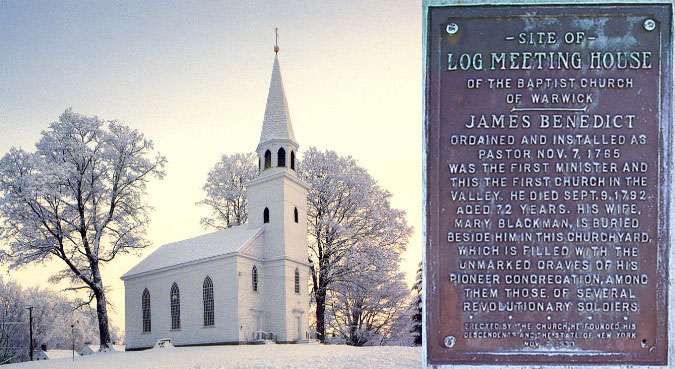 |
|
| Book Information |
Book Image
|
|
| Name: |
|
Early Settlers of New York State: Volume II |
| Author: |
|
Janet Wethy Foley |
| Publisher: |
|
Genealogical Pub. Co. |
| Year: |
|
1993 |
| Page: |
|
759 |
|
|
|
SOURCE INFORMATION: Early Records: Old School Baptist Church (bound issues of 1934 Magazine).
|
|
The Old School Baptist Church was formed in 1776 by James Benedict, of Ridgefield, Connecticut, who brought parishoners with him and was the pastor there until his death. The Cromptons (including William's mother-in-law, Johanna), were from the same area. The church began with only three members, but had increased to 57 "brothers" and "sisters" by 1769. In the year 1789, the church increased to 192 members. The "William House" family begins to appear in the record at this time, so we can assume that around this time William was "immersed" in the Wawayanda (Warwick) Creek, and baptized into the faith. Early church records of the church show members William House, Martha House and Simon House (cited as early members before dates were recorded in the church notes), John (1802), Jonathan (1802), William (1802), Martha (1789 and May 1, 1802), Polly (1803), and James (1821). William and Martha had no daughter named Polly, so she may have been the daughter of William's brother, John, who died in the Revolutionary war. As the eldest living son, William would've been responsible for her.
| Personal Information |
Census Image
|
| Name: |
|
John Haws |
| Township: |
|
Warwick |
| County: |
|
Orange |
| State: |
|
New York |
| Year: |
|
1790 |
| Roll: |
|
M637_6 |
| Page: |
|
147 |
| Image: |
|
0348 |
|
|
|
| Personal Information |
Census Image
|
| Name: |
|
William Hawse |
| Township: |
|
Warwick |
| County: |
|
Orange |
| State: |
|
New York |
| Year: |
|
1790 |
| Roll: |
|
M637_6 |
| Page: |
|
147 |
| Image: |
|
0349 |
|
|
|
SOURCE INFORMATION: Index created from United States of America, Bureau of the Census. Heads of Families at the First Census of the United States in the Year 1790.
|
|
| Personal Information |
Court Image
|
|
| Name: |
|
John Haus |
| Township: |
|
Warwick |
| County: |
|
Orange |
| State: |
|
New York |
| Date: |
|
8/21/1795 |
| Probated: |
|
9/ 1/1796 |
| Book: |
|
Liber A |
| Pages: |
|
379-381 |
| Executor: |
|
James Burt |
|
|
|
|
SOURCE INFORMATION: Orange County Surrogate's Office, Goshen, N.Y.
|
|
The 1790 United States census was the first United States census. It recorded the population of the whole United States as of Census Day, August 2, 1790, as mandated by Article 1, Section 2, of the Constitution and applicable laws. In the first census, the population of the United States was enumerated to be 3,929,214 inhabitants. Both Secretary of State Thomas Jefferson and President George Washington expressed skepticism over the results, believing that the true population had been undercounted. But not because of this particular Hause family: They showed up in huge numbers! According to the census, JOHN HAUSE (his last name spelled "Haws"), now in his late sixties or early seventies, was still living with his wife, Sarah, in Warwick (named as such by an act of the State Legislature on March 7, 1788). He had seen many of his family members die during the bitter, bloody revolution, including (possibly) two sons in the same battle. WILLIAM HAUSE (spelled "Hawes") was listed in the very next column of the census, on the same page, living just a few miles away.
Sadly, John wouldn't make an appearance in the next census, as he died in 1796. His last will and testament is transcribed at right. In it, he wills his "beloved ownly son William" a bay mare and a black cow with a white face, and all of his clothes. The rest was to go to the support of his wife, Sarah. In the event of her death or remarriage, a quarter of that property was to go to John's grandson, John (son of Simon Haus), and the rest would go to William. Sarah, was then residing with William and his family in the 1800 census.
If John was buried according to the customs of the time in the Reformist church, then his body was laid in state on a stretcher-like "bier" at the family home for three days, partly so that if he was pronounced dead in error he wouldn't be under six feet of dirt when he woke up. There was a lavish funeral meal, with abundant drink, as was the custom in German families. Then John would have been carried to the church in procession by four to six bearers—usually the village poor. They carried the casket while the appointed pall bearers, family and friends, had the easier task of simply holding the pall. John would then have been laid with his feet facing east in the church, as a sermon and prayers were recited. Then after the service ended, he was carried out and buried at a spot now lost to time.
|
THE UNITED STATES IN THE EARLY 1800'S:
|
|
The average life expectancy was about 35-40 years. A white man who had reached his 20th birthday could expect to live just another 19 years. A white woman at 20 would live, on average, only a total of 38.8 years. If measuring from birth, which counted infant mortality, life expectancy would have been even lower.
25 percent of women died from complications of childbirth. A white family would typically have seven or eight children, but one would die by age one and another before age 21.
Nearly fifty percent of children born in the US died before they were 16.
The US population reached 5,309,000—about a million were slaves. The global population finally reached one billion people. (We now add a billion people every twelve years.)
The population density of New York State was twenty people per square mile.
The average value of land across the country was $10 an acre.
The average wage in New England was sixty-five to seventy cents a day.
Universal manhood suffrage did not exist, and very few laborers could vote.
There was no legal restriction on the employment of children. Employers were allowed to whip women and children to "urge them to work."
Many schools had "whipping posts," to which a bad pupil could be bound while he was being flogged.
Whiskey and rum were so prevalent that they were even served to prisoners in jail.
A newly established stagecoach line was offering "speedy" six-day service between Pittsburgh and Philadelphia.
The punishment for adultery in Virginia was a twenty dollar fine. However, if an adulterer was killed by the wronged party, it was generally never prosecuted by the law, because the general public approved.
Mercury was considered a cure-all by doctors, as was opium. The blistering and bleeding of patients was an accepted practice, too. Bloodletting was thought to lessen fever and purge disease. It was performed by a barber instead of a surgeon.
On February 15, 1804, New Jersey became the last northern state to abolish slavery.
On March 26, 1804, Congress ordered the removal of Indians east of Mississippi to Louisiana, as the Territory of Orleans was organized in the Louisiana Purchase.
On May 14, 1804, Lewis & Clark set out from St. Louis for the Pacific Coast.
In 1813, the average property owner in Warwick paid $3.38 per year in taxes. John Hause's "trusty friend" James Burt's property was assessed at $6240, and he paid $8.65. A ten-acre tract of prime cleared land was valued at $150.
In 1816, the last witchcraft trial in New York State took place at the Declark-Polhemus gristmill in Rockland County. Jane (Naut) Kannif, a widow of a Scottish physician, was knowledgeable about herb medicines and was accused of practicing witchcraft. Naut was weighed against a large brass-bound Dutch Bible on the large flour balance. Jane outweighed the Bible and was judged innocent.
|
|
| Book Information |
Book Image
|
|
| Book Title: |
|
N. Y. Colonial Manuscripts: Indorsed Land Papers in the Office of the Secretary of State of New York. 1643-1803 |
| Publisher: |
|
Weed, Parsons & Co., Albany |
| Year: |
|
1864 |
| Volume: |
|
L, page 2, 31 Dec 1790 |
|
|
|
|
SOURCE INFORMATION: University of Pittsburgh; Americana. Contributor: University of Pittsburgh Library System. (Online Image)
|
|
More changes were in store for the Hause family, and everyone else in old Orange County, which had remained unchanged for over a hundred years as one of the first 12 counties in the New York Province. To meet the needs of the growing populace, the County of Rockland was set off from the south-eastern portion of Orange in 1798. The old courthouse and gaol (jail) in Tappan, with its whipping posts and stocks, had burned to the ground in 1774. (As such, British Major John André had to be held in a local tavern while he was tried for espionage at the Reformed Church, then hanged and buried nearby in 1780.) So New City, a hamlet in the town of Clarkstown that had been inhabited mostly by Lenni Lenape American Indians before the Revolution, became the seat of government for the county, just 18 miles north of New York City. The location was distant for William and other residents but convenient for the new government, since travel in the area was still difficult, and the other towns in the county were not centrally located.
|
| Court Record |
Image
|
|
| Name: |
|
Hawes, William |
| Location: |
|
Jersey Gore |
| State: |
|
NY/NJ |
| Year: |
|
1795 |
| Box: |
|
6 |
| Folder: |
|
19 |
| Item: |
|
625 |
|
|
|
|
SOURCE INFORMATION: Sterling Iron and Railway Company Records, 1740-1918; List of a panel of jurors for the trial of James Jackson and others vs. Wm. Hawse (nysed.gov).
|
|
On 5 June 1795, William went to court in a case likely involving the disputed land that he inherited from his father along the Jersey Gore. A jury was selected in the case of James Jackson, John Taylor, William Smith and Thomas Smith (relatives of Claudius?) vs. William Hawse. His old regiment colonel from the revolution, Gilbert Cooper, was on the jury list but wasn't picked.
The content and outcome of the trial is not revealed in the document, although since William was still on the property after 1800 he probably came out of it all right. In 18th-century America, "squatter's rights" were a practical way for settlers to gain legal ownership of land they occupied without a formal grant, particularly on the frontier. Settlers improved and cultivated land they considered unclaimed, and colonial governments often eventually recognized these claims, effectively legitimizing them through use and settlement. But it wouldn't be until years later that he could legally own the property.
|
| Court Record |
Image
|
|
| Name: |
|
Hawes, William |
| Township: |
|
Warwick |
| County: |
|
Orange |
| State: |
|
NY |
| Year: |
|
1800 |
| Roll: |
|
M32_21 |
| Page: |
|
375 |
| Image: |
|
378 |
| Slaves: |
|
0 |
|
|
|
|
SOURCE INFORMATION: 1800 United States Federal Census. M32, 52 rolls. National Archives and Records Administration, Washington DC.
|
|
Although the ownership of the land was still in question, fifty-year-old William was still living on the state border in disputed lands, but he was placed in the Warwick area of Orange County for the 1800 Federal Census, with ten people in his household. His family was continuing to grow, with the marriages of his oldest children, John (1796, to Esther Ketcham), Johanna (to Michael Weymer, pre-1802), Simon (1800, to Mathia Demand), and the births of another Hanna (1796) and Morris (1797). William began to consider their prospects. He had a sizable 220-acre farm, himself, but he didn't own it, and even if he got the title, splitting that property between 14 kids wasn't going to offer them much opportunity to succeed. Meanwhile, property out west was becoming plentiful and cheap, because the Iroquois, having sided with the British and Tories in the war, had been forced off the land. So William probably started considering a move west, where his descendants could prosper.
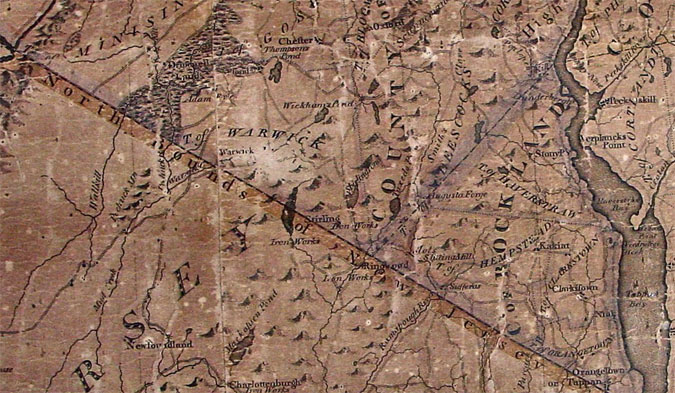
A map of the New York/New Jersey border in 1802, by Simeon Dewitt, with clarified state borders. The town of Warwick is in the center, and Haverstraw is to the right. From the collection of the Historical Society of the Town of Warwick. (Click here to enlarge, or click here to see a modern map.)
|
|
| Book Information |
Book Image
|
|
| Name: |
|
Laws of the State of New-York, Passed at the Twenty-Third Session of the Legislature |
| Author: |
|
State of New-York |
| Publisher: |
|
Loring Andrews (Albany) |
| Year: |
|
1800 |
| Pages: |
|
141-143 |
|
|
|
SOURCE INFORMATION: Laws of the State of New-York, Passed at the Twenty-Third Session of the Legislature, Begun and Held at the City of Albany, the Twenty-Eighth Day of January, 1800; Chap. 75, "An Act Directing the Surveyor General to Sell Certain Vacant Lands in the Counties Of Orange and Rockland" (collection of the author)
|
|
Finally, in 1802, William was able to purchase the 220 acres that he had developed near the "Man-of-War" Rock—the old hideout of Claudius Smith—for twenty-five cents per acre from the state of New York. We know this from an act passed by the New York Legislature on March 28, 1800, dealing with a petition presented by William and members of the Drew, Conklin, Sanford and Ketchum families, stating they had settled and improved the unpatented land. They lived on the "Wawayanda," a land grant in colonial New York that comprised 150,000 acres of land bounded on the east by the Highlands of the Hudson, on the north by the county line between Orange and Ulster counties, and on the south by the colonial division line between New York and New Jersey. Boundary issues between New York and New Jersey meant the homesteaders couldn't buy their land until the state borders were drawn. By 1800, the land William resided on was declared to be New York, and the acts passed by the state legislature on the 28th of March started the process by which William could be a landowner.⁹
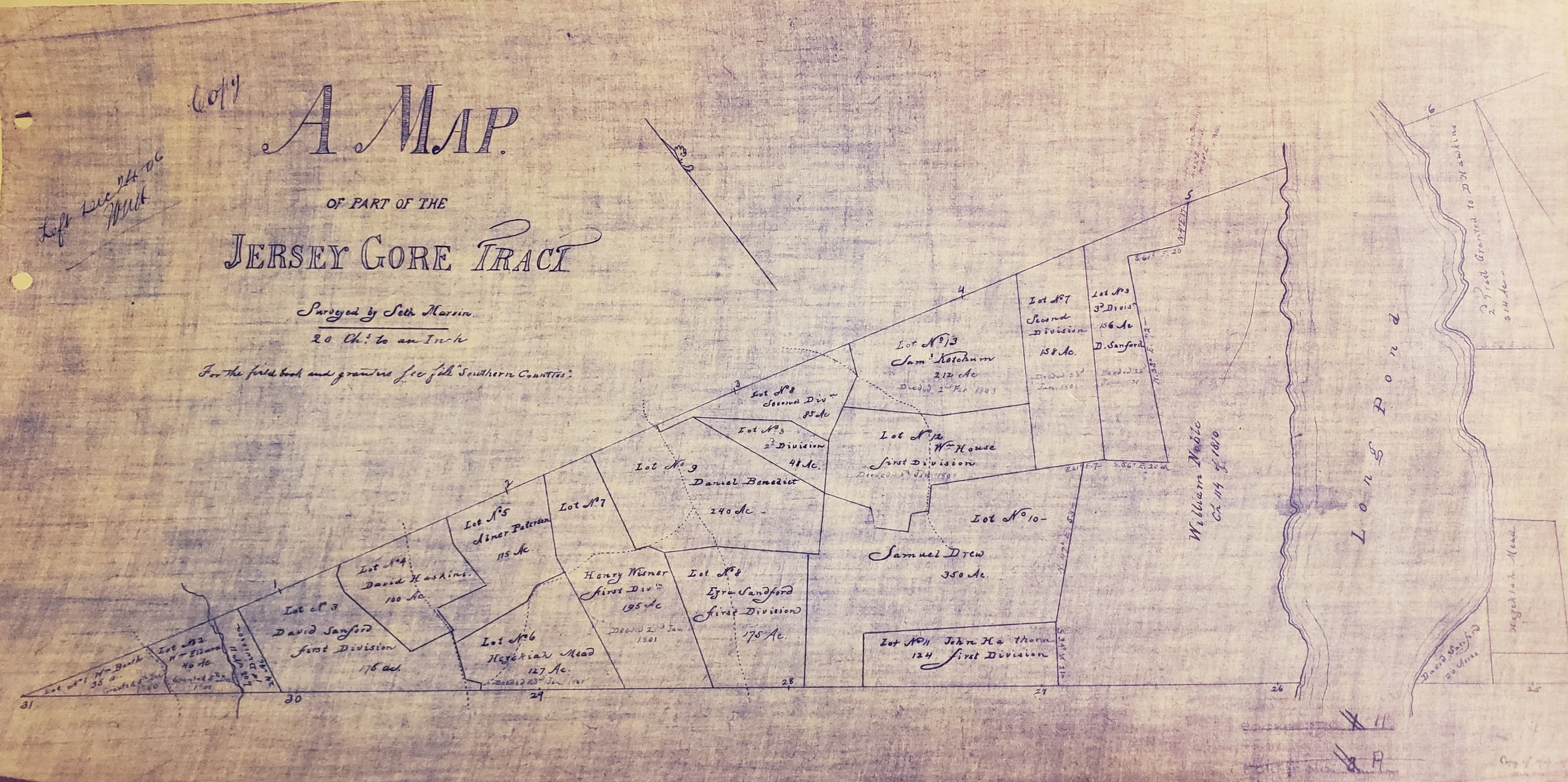
Map of the Jersey Gore by Seth Marvin (Greenwood Lake area): Likely drawn between 1803 and 1830, based on dates noted & life span of some of the owner names. Copy done at unspecified time; this copy from map in the collection of the Orange County Clerk's Office. This map reflects land ownership as a result of a March 28, 1800 act of the NYS Legislature, granting land to those settled on the Gore; each to have not more than 400 acres, nor less than 100, upon payment of 25 cents per acre into the State Treasury. (Click here to enlarge, or click here to see more maps.)
|
An indenture, dated February 11th, 1802, describes where William's land was located: on the Orange Turnpike and Ramapough Creek, just south of the Man O' War Rock. (Today the house is long-gone, and the Highway Department has destroyed most of the rock, but a framed sketch of the cabin hanging in the Tuxedo Park library gives us a good idea of the homestead.) Most importantly, as a recognized landowner in New York, William was finally attaining his dream, and the family's as well.
But then something strange happened just two weeks later: Another indenture, made on Feburary 28, 1802, has William selling the same property, at a loss, to his daughter Hannah (Weymer), for twenty cents per acre. With this impressive loss of investment, William began his career as a land speculator.
|
| Personal Information |
Indenture
|
| Name: |
|
Hause, William |
| Township: |
|
Warwick |
| County: |
|
Orange |
| State: |
|
New York |
| Date: |
|
2/11/1802 |
|
|
|
|
| Personal Information |
Indenture
|
| Name: |
|
Hause, William |
| Township: |
|
Warwick |
| County: |
|
Orange |
| State: |
|
New York |
| Date: |
|
2/28/1802 |
|
|
|
|
New York had instituted the policy of granting bounty lands on 20 Mar 1781, followed by subsequent acts. The tract that the state had chosen for bounty lands was in the choice Finger Lakes region of central New York (so named because the Iroquois believed the Creator left two hand print signatures there after finishing the world). It was called the "Military Tract," and included the present counties of Cayuga, Cortland, Onondaga and Seneca, as well as parts of Oswego, Schuyler, Tompkins and Wayne. There were twenty-eight townships altogether, and the whole tract contained over one and a half million acres. Each township contained 60,000 acres, subdivided into farm lots of 600 acres.
William didn't actually move for a decade, until he was able to buy the land he had improved. That's when he sold his land to his daughter for less than he paid the state to acquire it. Then, he and the rest of the extended family (other than son Johnathan, who passed away that year in Jamaica, Long Island) moved northwest through modern-day Pennsylvania, up into the "Finger Lake" region of New York:¹º
|
| Personal Information |
Deed Image
|
| Name: |
|
Hause, William |
| Township: |
|
Ovid |
| County: |
|
Seneca |
| State: |
|
New York |
| Years: |
|
1804-09 |
| Source: |
|
County Clerk, 1 Di Pronio Dr, Waterloo,
NY 13165. Phone: (315) 539-9294 |
|
|
|
|
| Personal Information |
Deed Image
|
| Name: |
|
Hause, William |
| Township: |
|
Wayne |
| County: |
|
Steuben |
| State: |
|
New York |
| Years: |
|
1811-15 |
| Source: |
|
County Clerk, 105 9th St., Box 8, Watkins Glen, NY 14891. Phone: (607) 535-8133 |
|
|
|
|
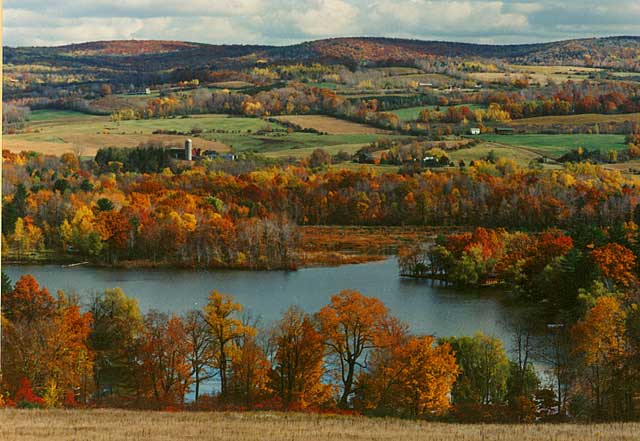
Lamoka Lake, near Tyrone, as seen from Hause Hill (click to enlarge). |
|
On February 22, 1804, William sent his sons, Jonah and Simon, ahead to purchase land (part of Military Lot 71) near Cayuga Lake in the township of Ovid, Seneca County, from Richard Pelton and his wife, Jane, for thirty-two dollars. Then on March 14th he bought a much larger chunk of the Military lot from Samuel Johnson (Jonas is recorded as the buyer) for sixteen hundred dollars. On June first of the same year he purchased more of the lot for one hundred dollars from Tunis Rappleye and his wife, Catharine. On November 7, 1807, he purchased still more of the lot from John Kelly for two hundred and twenty-five dollars. Finally on February 4, 1809, for fifty-five dollars he purchased the remainder of the lot from John Kelly. (According to an account by William's grandson, Charles, most of these people were probably squatters who had already settled the land.) William's son, John, and his family eventually moved onto the property. The fortunes of the Hause family were definitely changing, although tragedy struck during this time as well, with the death of William's sixth son, Allen, still a teenager.
According to "Portrait and Biographical Record of Seneca and Schuyler Counties, New York" (Chapman Publishing Company, 1895), William's son, Joseph, "and an Irishman (ex-Senator Francis Kernan's father) went across Seneca Lake and settled in Tyrone, to which point they presently removed their families." William and the rest of his family then moved to Steuben (now Schuyler) County.
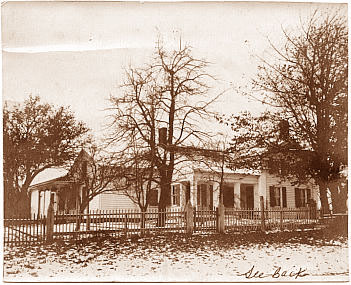
William's house on Hause Hill, as it looked in the early 20th Century. It burned down in the 1940's. |
|
The area was occupied by Native Americans until 1789, when the first permanent settlement was established by Frederick Calkins. (It was named after Baron Von Steuben, a Prussian who taught military skills to George Washington's forces.) Bath, the county seat, was founded in 1793 by Colonel Charles Williamson, and was the first planned community in western New York. Today it's the gateway to the fourteen county Finger Lakes Region.
The first settler was Isaac Stark, who arrived there from New Jersey in 1807. It was first called Stark's Mill, then Harpending's Corners after Samuel Harpending, who arrived in 1811. The Hause family arrived soon after. According to deeds, on March 9, 1811, William bought forty acres from Nicholas and Alice Low of the City of New York Esquire and Alice Low his wife for the "sum of one hundred Dollars to them in hand paid." The same day, William bought fifty more acres for a hundred and twenty-five dollars from Elkanah and Rachel Watson of Pittsfield, Massachusetts, through their attorney, Samuel Haight. Over the next few decades, William, his sons, and eventually his grandsons made a great many land deals in this area.
William and his family settled in the village of Wayne, which would one day become the blackberry capital of the world (they still grow wild on the property, along with Concord grapes and sour cherry trees). William worked a 200-acre farm, with a house that was said to have been built in the 1700's. The area they lived in is straddled by Waneta Lake and its neighbor sister, Lamoka Lake, sometimes known as the "Baby Finger Lakes."
Wilma Perry, who grew up in the same house during the 20th Century, remembers it as "a beautiful home with polished walls and floors. It burned down in 1948." William also built a barn in 1811 that survived until 1965!
WILMA PERRY: THE LAST PERSON TO LIVE IN WILLIAM'S HOUSE
|
|
| Newspaper Article |
Image
|
|
| Newspaper: |
|
Dundee Observer |
| Submitted by: |
|
Wilma Teed Perry |
| Article: |
|
"Neighbors Notes" by Wanda Howell |
| Date of Publication: |
|
Wed., 30 Sep 2009 |
|
|
|
|
SOURCE INFORMATION: Letter from Wilma Teed Perry to the Dundee Observer, 45 Water St, Dundee, NY. Tel: 607-243-7600.
|
|
Wilma Perry: "For four years I did live in the old William Hause house... It is registered as the highest point in Schuyler County... The porch had beautiful lattice on both ends... The cellar was deep. It had to be hand dug. The bottom of the cellar floor was laid in huge flat stones. The walls were cobblestone. After the fire one side of the cellar was cleaned and the other side was filled in... The foundation stone I found for the Hause house. It is several feet in back of the cinderblock house. I remember looking at it and my mother telling me it was the original foundation. It was a big house... The outside steps were a work of art. The floors of the house were flat boards fitted down. I suspect they were 'pegged' ... In the house there was a stone chimney... The kichen was big and it had a big pantry. There was a door that shut off the stairs. The stairs led up to three rooms... Rich red roses came up in the yard, and they were beautiful. The roots must have been in the soil for several years before coming back. I think there were a lot of roses and maybe a white fence. it sounds so beautiful I wish I had asked my mother for a cutting from those rose bushes!"
|
More 20th Century photographs of William's property (left to right): The barn, which stood until the 1960's; A pond near the barn; some of the farmland, which is now used to raise beef cattle.
|
|
| Periodical |
Image
|
|
|
| Title: |
|
The Swing in the Old Chestnut Tree |
| Author: |
|
Wilma J. Perry of Watkins Glen, N.Y. |
| Subject: |
|
William Hause's house on Hause Hill, Schuyler Co., N.Y. |
|
|
|
|
|
"I played in the granary of the barn. It was made of the same kind of wood that was in the Hause house. It had smooth white boards, and it looked like a parlor in an old country home... The inside of the barn was just beautiful. It had a balcony and stairs... The Hause farm is still active. Beef cattle are raised on it ... The house was about a three minute walk from the cemetery... The Hause family were wealthy. Now, if you travel up there, you see very bad poverty. The roads are still gravel. Times have changed from great wealth to great poverty. The hill is very poor, (but) there is something so rich about the settlement of the Hause family. I had the 18 years to soak up a lot about the house, farm, and cemetery. It was all good stuff."
—Wilma Teed Perry, culled from various letters to genealogist Dona L Teske. Wilma was a descendant of the Spears family, who came from New Jersey and took over the farm on Hause Hill after the Hauses left. Her great, great, great, great uncle Abraham Spears (1750-1818) fought in the Continental Line during the Revolution, and is buried near William in the cemetery.
|
William's family had several residences in the area by the time of the 1810 census, taken on August 6th. William's property on "Hause Hill" was now considered in Wayne, Steuben County, New York.¹¹ Sons William Jr. and Simon were listed as heads of families directly underneath their father on the census. The next-door neighbor, Revolutionary war veteran William Harris (who Wilma Perry recalls being told was an "Indian trader") had married William's recently widowed daughter, Sarah Hause-Johnson. William's eldest son, John, was now living in Fayette, Seneca County, New York (just having left Ovid), and is registered on a different sheet:
|
| Personal Information |
Census Image |
|
| Name: |
|
Hawes, William |
| Township: |
|
Wayne |
| County: |
|
Steuben |
| State: |
|
New York |
| Roll: |
|
M252_37 |
| Page: |
|
391 |
| Image: |
|
55 |
|
M, 10-15:
|
|
1 |
|
M, 16-25:
|
|
3 |
|
M, 45+:
|
|
1 |
|
F, 10-15:
|
|
1 |
|
F, 45+:
|
|
1 |
|
|
|
|
|
| Personal Information |
Census Image
|
|
| Name: |
|
House, John |
| Township: |
|
Fayette |
| County: |
|
Seneca |
| State: |
|
New York |
| Roll: |
|
M252_36 |
| Page: |
|
203 |
| Image: |
|
128 |
|
M, 1-9:
|
|
3 |
|
M, 10-15:
|
|
1 |
|
M, 26-44 :
|
|
1 |
|
F, 1-9:
|
|
3 |
|
F, 26-44 :
|
|
1 |
|
|
|
SOURCE INFORMATION: 1810 United States Federal Census. M252, 71 rolls. National Archives and Records Administration, Washington DC.
|
|
| Personal Information |
Court Image
|
|
| Name: |
|
William Hause (deceased) |
| Subject: |
|
Letter of Administration |
| Township: |
|
Wayne |
| County: |
|
Steuben |
| State: |
|
New York |
| Date: |
|
8/18/1818 |
| Book: |
|
Liber 1 |
| Pages: |
|
392 |
| Surrogate: |
|
John Metcalfe |
|
|
|
|
SOURCE INFORMATION: Steuben County Surrogate's Office, 3 Pulteney Square, Bath, NY 14810-1573.
|
|
The family escaped any tragedies for several years, despite at least three of William's sons fighting in the War of 1812 on the Niagara Frontier: the eldest son, John, was a sergeant who was taken prisoner at the Battle of Lundy's Lane and imprisoned in Canada. John was released after the war, and he returned home to his farm in Seneca County. Meanwhile, William, Jr. returned to Hause Hill, and Morris married and moved out west.
William Hause died on May 20, 1818. His letters of administration, on file in Steuben County, can be viewed at right. We have no record of William's funeral, but it was probably held at the Baptist Church of Jersey, at the bottom of Hause Hill in what is now Altay. The church was constituted on November 22, 1815, and Phineas Fullerton was licensed to preach. He supplied the pulpit part-time for a few years, but in 1818 he was excluded for intemperance. (Maybe he had had a few too many drinks at William's wake.)
William's land was then partially sold by his heirs to his son, Matthew, on April 13, 1819, and the rest was sold to Samuel on January 10, 1820, although many of William's children remained in the area afterwards and prospered. William Jr., Joseph, and Morris became active in government, as did the Harris's, Swarthouts, and Sanfords, and on April 16, 1822, they helped form the township of Tyrone in the county of Steuben—taken from Wayne township at the 45th annual session of the legislature of New York. The first town meeting was held at Joseph Hause's tavern,¹² which advertised as, "A resting place for man and beast."
|
| Personal Information |
Indenture
|
| Name: |
|
Hause, Matthew |
| Township: |
|
Wayne |
| County: |
|
Steuben |
| State: |
|
New York |
| Date: |
|
4/13/1819 |
| Source: |
|
County Clerk, 105 9th St., Box 8, Watkins Glen, NY 14891. Phone: (607) 535-8133 |
|
|
|
|
| Personal Information |
Indenture
|
| Name: |
|
Hause, Samuel |
| Township: |
|
Wayne |
| County: |
|
Steuben |
| State: |
|
New York |
| Date: |
|
1/10/1820 |
| Source: |
|
County Clerk, 105 9th St., Box 8, Watkins Glen, NY 14891. Phone: (607) 535-8133 |
|
|
|
|
Martha Wood Hause passed away on 08 Sep 1822 and was buried beside her husband in the family cemetery. After the death of their matriarch, the strongly-allied Hause family began to fragment. Some of the children moved on to other parts of New York, while others moved on to Pennsylvania, Wisconsin, and Michigan. William's property eventually passed to the Spear(s) family (there may have been a family connection in the sale, as the 1854 will of Barney Spears on Hause Hill lists a "Polly House" as his daughter), who owned it for the next hundred years, until the land was passed to the William Teed family, through his marriage to Clara Spears, in 1940.
Today the area where William lived is now in the town of Dundee, in Yates County. It is still very rural and underdeveloped,¹³ but there are some signs of modern civilization: Well-to-do families vacation there during the summer at expensive homes on the shores of the Seneca, Waneta and Lamoka Lakes. Watkins Glen, the county seat, has an internationally famous Grand Prix car race every year; Even the Amish have turned somewhat white trash—in 2006, I drove past one Amish homestead in which the farmer actually had his horse cart up on blocks in the front yard. But fortunately, the hills over Tyrone have remained largely unchanged. In fact, if you drive up the spindly 226 and turn left onto tiny Kendall Road, it empties onto an even tinier dirt path (grandly called Pulver Road) where you'll eventually find an overgrown walking trail leading into the woods. When you cross a brittle wooden bridge standing over the weed-choked roadside ditch, and work your way through the dense foliage and poison oak, a tiny monument becomes visible through the leaves: A metal D.A.R. plaque announces that this ground is the final resting place of William Hause. (The actual headstone disappeared many years ago. Whatever the inscription said has been lost forever.)
William remains tucked away there with Martha in the tiny private graveyard on Hause Hill. It's a small, humble graveyard, befitting the simple Baptist couple. William and Martha are buried near their daughter, Sarah, and son-in-law, William Harris (he also has a plaque there, honored as a D.A.R. Patriot¹⁴).

The grave of William E. Hause pokes through the trees of the Hause Hill Cemetery in Schuyler County, New York (it was then called Dundee, in Yates County). Click here to see more of the cemetery.
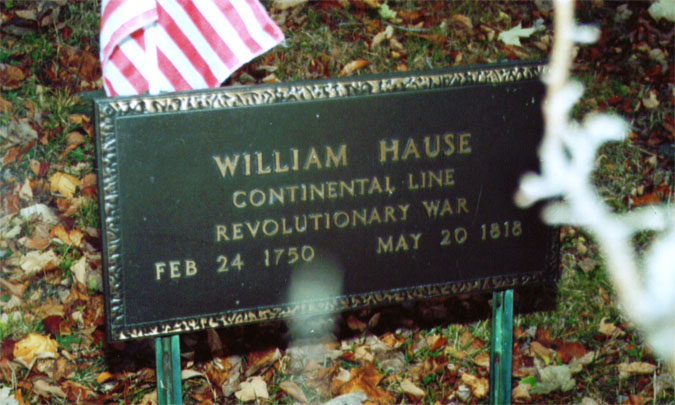
|


(From Jerry Hause's Family Bible)
|
|
CHAPTER FOUR: JOHN HAUSE AND WESTERN NEW YORK, 1800-1855. Revolutionary War heroes become prosperous land owners. The Hauses then spread out across the state of New York. So John begat William who begat John who begat Augustus. Then Augustus begat a generation that moved west...
NOTES ON THIS PAGE:
¹—A full account of this story can be read in "Jonas Wood UEL," by Elizabeth Hoople (Glengarry Historical Society), Wood Research Team, 1984. Stormont, Dundas and Glengarry, Ont. 33 pages. (An excerpt can be read at the bottom of the Wood Family Genealogy page.) Jonas lived about 40 miles from Warwick by the time of the war, and was a cousin of Martha. Her brother Joseph (and either her brother Jonathan, Jr., or her father, Jonathan Wood, Sr.) fought for the Rebels in Orange County. So while it wasn't "brother vs. brother" in the Wood family, it was at least "cousin vs. cousin."
If you believe William's mother was Sarah Wheeler, her family was divided equally between Loyalists and Rebels, as well. His uncle George Wheeler, still living on a tenant farm of 200 acres in Livingston's manor, had sons in the British army, and during the war he would be imprisoned several times with his wife, son, and daughter—even put in irons at one point. (He would eventually relocate to New Brunswick, Canada.) As for the petition that William signed, "Reynard House Sr." refused to sign the document, while "Reynard Jr." signed a revised version that was still loyal to the King. Family members fighting with William in Hay's Levies were Richard House, and the father-son team of Rinard Sr. and Jr. (One of them may have been the Americanized "Richard," as well.)
²—In 2006, I was visiting Albany and discovered that our family enemy, General Howe, was actually buried in the Episcopal Church in that city. Apparently he was killed in battle, and was due a Nobleman's burial in England. Unfortunately for the general, it took four days for his soldiers to transport him all the way to Albany for transport back to England, and his smell wasn't so noble by that point. He got so ripe that his men, not wanting to smell the carcass all the way across the Atlantic, dumped him in the official church of England, figuring that burial in the basement would be good enough.
³—Believe it or not, we finally have a Hause legend that the facts seem to substantiate! Family lore states that, "John Hause, who was killed at White Plains, had two children, John and Polly. John Hause's Widow, married a Benjamin Butler, and had six children. That part of Orange Co. where he died is now Rockland County, NY." The 1790 United States Federal Census reveals a Benjamin Butler in Minisink, Orange, New York, with 2 household members. Ten years later, a Benjamin Butler and wife have six kids in Northumberland, Saratoga, New York (Year: 1800; Census Place: Northumberland, Saratoga, New York; Roll #27; Page #1143). Also, a "Polly" Hause is listed with William's family in the records of the Old School Baptist Church in Warwick, while no daughter of that name was ever recorded for John III or William. But certain facts seem to suggest that John and Simon would actually be William's brothers: It has been reported that John III's son, named Jonathan, substituted for him in the war out of Warwick (a legal practice at that time). Furthermore, a will by John Hause in 1796 mentions a wife, Sarah, a son, William (the only son still living, according to the text), and mentions a grandson, John, through his late son, Simon.
Another Simon Hause is found in the muster roll of the 5th New York Regiment, which also fought at White Plains. It lists "Simon Hauss" (also spelled as "Hause" and "House" in other documents) as a deserter in 1778! However, research by genealogists Kirk Moulton and Dan Kinsey, working on the Secord and Haas families, uncovered that this soldier is not the Simon Hause of Orange County. Instead, these records belong to Simon Haas of the Claverack area, son of Zacharias Haas. The Simon Hawes of Orange County we know from the Erskine Maps, ca. 1775 to 1783, which show that he lived at Beaver Pond, due west of Fort Montgomery. This Simon must have relocated about the time that John Hause did before the war, and has no known Service Records. Beaver Pond sits at the lower end of Lake Welch, in the former village of Sandyfields, settled in 1760, condemned in 1928 with the last residents removed from their homes in 1939. Forgotten now, it must have been important to the war effort, as it appears on Washington's maps along with Simon's residence. Still another Simon appears in the book "The Loyalists at the Battle of Fort Ninety Six," by Bobby Gilmer Moss, which details Tory musters including "Simon Hawes" (whose name was also spelled variously "Hanse" and "House," depending on whose muster you read). He fought as a private, and then a corporal in the first Battalion of Brigadier General Oliver Delancy's Loyalist New York Brigade, from 20 Nov 1779 until 1 Jan 1783, when he died. Although this scenario is less glorious now, it fits in the timeline of John Hause's will, and needs to be included. If this is the same Simon, it truly proves how this war was "brother against brother."
⁴—Documents Relating to the Colonial History of the State of New York, Volume XV; State Archives, Vol. I, Edited by Berthold Fernow. Weed, Parsons and Company. 1887. Page 390: "William Hause, Cooper Regiment, Blauvelt Company"; "William Haws, private, Pawling Regiment, Wood Company."

|
It should be noted that there were actually two militia men named William House (or Haus, Hause, or maybe Hughes, depending on the document) in Orange County during the Revolution. Today we only have the first-hand recollections of one of them: WILLIAM HOUSE was born in 1756, in Haverstraw, to Rheinhardt Haus II. The Reformed Church in Clarkstown listed a William Hous and wife, Weyntje Oblienis baptizing their son, Henderick, on 6 Dec 1795, and a daughter, Grietje, on 10 Dec 1798 with Marya Springstill. This William also fought in the Orange County Militia, according to his mid-1830's pension application. After the war, he moved to Cornwall and became, "a pioneer Baptist minister, who was located in Orange County. He was a man of strong faith and of great force of character, and was a masterful figure in those early days. He passed through many trials usual to pioneer preachers and was peacefully laid to rest, leaving three sons: Henry, Rheinhardt and Bradner, the two former sons of his first wife. He was twice married. His first wife was an Oblenis, of Clarksville Corners... Mrs. O'Blenis, first wife of Rev. William House, of Clarksville Corners, had two sons, Henry and Rheinhardt. Second wife had several sons, only one now living, Bradner, who is a Baptist minister. (From: Historical Record to the Close of the Nineteenth Century of Rockland County, New York, PART II, BIOGRAPHICAL, by Arthur Sidney Tompkins. Van Deusen & Joyce, 1902. Page 22) Fortunately, the names of the parents, wives and children of the two Williams are totally different, making it easy to differentiate them in church records and legal documents.
The pension request, in which he recalls all of his tours of duty, states that he fought for ten months under Captain Amos Hutchins in the Fifth Regiment. Searching through all of the available literature, the Fifth Regiment muster rolls don't list this man, only a "William Hughs." So either he was wrong or somebody couldn't spell. (Ironically this was the same Regiment that featured "Simon Hause" the deserter!) Anyway,this William doesn't list Pawling's Levies in his war record. Because of this, it can reasonably be assumed that the man in Pawling's unit was indeed our ancestor, the other William Haws/House/Hause of Orange County. We can't be sure what happened to William House, exactly, but his pension request from the 1830's says that he is living alone in Cornwall, penniless, nearly blind and in failing health... and on top of that bad luck, they rejected his pension request.
⁵—New York in the Revolution as Colony and State, Vol. 1 & 2 (Vol. 1) Albany, New York: Weed-Parsons Printing Company, Albany, New York, 1897: The Provincial Congress on March 11, 1780, authorized a draft raising levies for the defense of the frontier. Colonel Albert Pawling was commissioned as Colonel of Levies. Thomas Dewitt, Major; Adjutant Cornelius Du Bois. Pawling was again commissioned as Colonel of Levies on April 27, 1781. Dewitt appears again as Major, along with Elias van Bunschoten. Richard Sackett, mentioned in a previous post, appears here as Captain. This draft was for "the immediate defense of the State." Army and Navy Chronicle, Volumes 4-5, From January 1, to June 30, 1837, edited and published by Benjamin Homans; Washington City: 1837. Albert Pawling's obituary appears on page 336: "At Troy, on the 10th inst. Col , ALBERT PAWLING, in the 85th year of his age. He joined the revolutionary army, in 1775, as a second lieutenant, in the regiment commanded by Colonel James Clinton, and shortly after marched with him into Canada, and joined that part of the army under the command of Gen. Montgomery, and remained there, sharing in all its dangers and privations until the next spring, when he returned to the State of New York. Shortly after his return, he was appointed Brigadier Major, by Gen George Clinton, and served with him as such until the summer of 1777, when he received the appointment of Major in one of sixteen additional regiments, which was commanded by Col. W Malcolm, and served under him until the summer of 1779. He was then appointed Colonel of a regiment of Swiss, raised for the defence of the frontier of the Slate of New York, in which he continued until the close of the war. He was in various battles during his important services, among which the taking of St. Johns, at the assault of Quebec, by Gen. Montgomery, and was near that officer when he fell. He was in the battle of Monmouth and White Plains."
⁶—Portrait and Biographical Record of Seneca and Schuyler Counties, New York, Chapman Publishing Company, 1895. P. 174: "P. HALSEY HAWES, Clerk of Schuyler County, was born in the town of Hector, P this county, November 28, 1857, being the son of Joshua and Elizabeth (Halsey) Hawes. He represents the third generation of the family that has resided in this locality, his grandfather, Jonas Hawes, having removed hither in an early day and made settlement in the town of Hector, where he resided for a number of years, or until his death.
The father of our subject was born in Schuyler County, this state, on his father's farm in Hector. He became a member of the firm of Squires, Wilcox & Co., who were engaged in merchandising at North Hector. In 1875 he went to Michigan on a business trip, and died there. His wife, who still survives him, is a resident of Watkins. While he never became very wealthy, yet he was well-to-do, having through his excellent management and industry accumulated a competency, which enabled him to surround his family with every comfort and give his only child, our subject, an excellent education.
In the town of Hector, upon the old homestead of his grandfather, Halsey passed the days of childhood and youth. After spending some years in the public schools he entered Cook's Academy, where his education was completed. On leaving school he came to Watkins and secured a position as clerk for Charles S. Frost, with whom he remained for five years. In 1883 he entered the employ of Durland, Smith & Co., dealers in hardware, with whom he remained in the capacity of bookkeeper until January 1, 1894. In 1893 he was elected to the office of County Clerk, the duties of which he assumed January 1, 1894, for a term of three years. As an official, he is prompt, energetic, faithful and efficient, and the manner in which he is discharging the duties of his office is winning him the approbation of the people of the county. He is a stanch Republican, and never loses an opportunity to advance the interests of his party.
On New Year's Day of 1880 Mr. Hawes was united in marriage with Miss Jennie Macrury, daughter of John Macrury, a prosperous farmer of Schuyler County. They are the parents of three children, namely: Edna E., Chester A. and Margaret L. Socially Mr. Hawes is connected with Jefferson Lodge No. 332, F. & A. M.; Watkins Chapter No. 182, R. A. M.; and St. Omar's Commandery No. 19, K. T., of Elmira. With his wife he holds membership in St. James' Episcopal Church, in which he is a Vestryman. He is a man who possesses in a marked degree the confidence and respect of the people of the village and county, for his course in life has ever been upright and honorable."
⁷—Portrait and Biographical Record of Seneca and Schuyler Counties, New York, Chapman Publishing Company, 1895. P. 144: "THOMAS P. HAUSE is the proprietor and publisher of the Farmer Review, having founded it and begun its publication in the month of July, 1887, at a time when no paper had been published in the town for several years. It is an eight-column folio, local and independent, devoted to the interests of Farmer, and has appeared every week since its first publication. It has grown to considerable prominence, and has an appreciative and valuable patronage.
Mr. Hause was born in Ovid February 29, 1860, the son of Joseph and Nancy (Purdy) Hause, who were also natives of New York. Joseph Hause settled in Seneca County before his marriage, and taught school. The grandfather, also Joseph Hause, was one of the pioneers of Seneca County, and helped to clear up the virgin forests around Farmer. He and an Irishman (ex-Senator Francis Kernan's father) went across Seneca Lake and settled at Tyrone, to which point they presently removed their families. The Hause family trace their ancestry back to William Hause, who settled in Pennsylvania in 1750.
After the marriage of the parents in 1856, they resided in Ovid. The father died in May, 1864, and the mother in 1872. They had three children, all sons: Alfred B., Thomas P. and William J.
Our subject was born in Ovid, received his education in the village schools, and learned the printer's trade in the office of the Ovid Independent. In 1887 he came to Farmer. Previous to this, in 1881, he was married to Jessie E., the daughter of D. F. Frantz, and they have two children, Nancy E. and Frank E.
In politics Mr. Hause is independent, voting for the best men and measures, irrespective of party interests, and by strictly carrying out this principle he has made himself a power. The proportions of his office and the increase of his establishment show how much the people appreciate a candid and honorable newspaper. He began business with a Washington Hand-press, and with but little material on hand, and now has a steam outfit, with a Campbell Country Press, and one of the most complete country job offices found west of New York. He is sole owner of both the plant and the building. Mr. Hause is found among the members of Farmersville Lodge No. 183, F. & A. M., and Seneca Lodge No. 694, I. O. O. F."
⁸—History of Walworth County, Wisconsin, containing an account of its settlement, growth, development and resources...its war record, biographical sketches, portraits of prominent men and early settlers; the whole preceded by a history of Wisconsin...and an abstract of its laws and constitution, published by Chicago, Western historical company, 1882. P. 783: "MORRIS F. HAWES was born at Warwick, Orange Co., N. Y., Nov. 12, 1797, and in early childhood removed with his parents, William and Martha (Wood) Hawes, to Steuben Co., where he remained until about 21 years of age, and during which time he served as a volunteer (though but a boy) in the war of 1812. His father, also a native of New York, participated in the war of the Revolution, and the subject of this sketch was the youngest of a numerous family of boys. Mr. Hawes married, May 17, 1818, Miss Sarah, the eldest daughter of Capt. Nathan Lounsbury, of Rutland, Vt., one of Col. Ethan Allen's "Green Mountain Boys," of Revolutionary renown, who reached the remarkable age of 101 years and 8 months; dying at Rutland August, 1857. Soon after his marriage, Mr. Hawes moved to Chautauqua Co., N. Y., where he led for some twelve years the quiet, happy life of a prosperous young farmer, cheered and assisted by his loving and ambitious wife, a most loyal young helpmate. Though fitted by birth and education to grace a higher social station, she was ever light-hearted, brave and content, surrounded by her thrifty flock of girls and boys, of whom six were born to them during their residence in that State. About the year 1830, Mr. Hawes, hoping to better the prospects of his growing young family, made another push to the Westward, this time halting in Hillsdale Co., Mich., where he resumed his occupation of farming, and also kept for a time a small hotel, about half way between the villages of Jonesville and Coldwater, on the great stage route between Detroit and Toledo and Chicago. Here he remained until the spring of 1837, when becoming dissatisfied with his success and prospects, and hearing much from returning explorers of the wondrous beauty and fertility of the "Rock River Valley," he resolved to make one more advance, and this time to the famed prairies beyond all the great lakes. With Mr. Hawes, to resolve was to act, and with his heroic wife and arms full of babies, he set out for the Territory of Wisconsin, reaching what is now the town of Richmond in August, 1837. Here he selected a claim and erected a cabin—the first home of civilization in the township—and here, on Jan. 5, 1838, a son was added to his family ; the first born in the township, if not in Walworth Co. After a few months spent in improving his land, he sold the claim for $500, and located another, three miles to the eastward, on the town line between Richmond and Whitewater. On a corner of this farm was subsequently built, by Mr. Hawes and some three or four neighbors, the first schoolhouse in the town. The first teacher was paid $1.25 per week, Mr. Hawes' family constituting a majority of all the pupils. Nevertheless, the handful of settlers were in possession of a free school. For twenty years, Mr. Hawes continued to till the acres he had reclaimed, much respected by the growing community, by whom he was retained in the minor offices of the county for nearly the whole time, and by whom he was elected to the first Constitutional Convention, called at Madison Oct. 5, 1846. In 1857, his wife having long been an invalid, and his sons not following the chosen occupation of their father, Mr. Hawes decided to relinquish the cares of a large farm, and removed to Whitewater, where, on July 28, 1859, the gentle partner of his busy life folded her weary, loving hands in final rest. Of his family, the eldest, Lucretia, the wife of B. P. Plato, of Rock Co., died in 1866. Lucy, the second, died in childhood, in New York. Lucinda M. is the widow of Joel Clapp, late of Milwaukee; Lucena E. is the wife of William De Wolf, of Whitewater ; Lucius J. married Miss Eliza Hunter, of Maquoketa, Iowa, and lives at that place ; Lucerne E. married Miss Clara Beemer, of Albion, N. Y., and lives at Whitewater; Frances E is the wife of Dr. C. M. Palmer, of Colorado; Francis M. married Miss Jennie Housel, of Owen Co., Ky., and resides at Milwaukee ; and Dean M. is the wife of Hiram S. Teall, of the same city. A single incident of Mr. Hawes' career will sufficiently illustrate a strong feature of his character. When chosen to serve as a member of the Constitutional Convention, on arriving at Madison, and before qualifying, he was called home by the serious and subsequently fatal illness of his wife. He was detained so long that upon his return to the convention the duties of that body were virtually completed. He was then urged by his fellow-members to qualify, that he might be properly enrolled and receive his compensation as a member. This he stubbornly refused to do, claiming that he had performed no public duty for which he was entitled to compensation. He died at Whitewater Jan. 13, 1868, in the 71st year of his age. Few words are needed to give to the memory of Morris F. Hawes its fit place in the annals of this State. In all the relations of life he was a just man. With scarce an exception, he was honored and trusted and loved by all who knew him. He was punctilious and persistent in the discharge of every moral and business obligation. He lived an open-handed life of usefulness. He died no man's debtor. His name will be honored as long as they live who understand and value the virtue, the heroism, the wisdom and the dignity of the men who shaped the destinies of the proud State of Wisconsin."
|
| Periodical |
Image
|
|
| Title: |
|
Map of Jersey Gore |
| Map: |
|
166 |
| Repository: |
|
New York State Archives |
|
|
|
|
SOURCE: Map of Jersey Gore. [The Original, Orange and Rockland Counties] New York State Archives. New York (State). State Engineer and Surveyor. Survey maps of lands in New York State, ca. 1711-1913. Series A0273-78, Map #166 (original image).
|
⁹—Laws of the state Of New-York, passed at the Twenty-Third Session of the Legislature, begun and held at the city of Albany, the Twenty-Eighth Day of January, 1800; Albany: Printed by Loring Andrews & Company, printer to the state, 1800; Chap. 75, p. 523. "An Act Directing the Surveyor General to Sell Certain Vacant Lands in the Counties Of Orange and Rockland: Whereas John Hathorn, Peter Townsend, William Hause, Hezekiah Mead, Samuel Drew, Ezra Sanford, James McCann, William Booth, Daniel Benedict, Abner Patterson, William Ellis, David Sandford, Thomas Sandford, David Hawkins, Samuel Ketchum, Henry Wisner, Henry Bush, Samuel Bush, Abraham Smith, John Smith, Adolphus Shurt, Nicholas Conclin, John Becraft and John Jenkins by their petition presented to the legislature have stated that they are settled on, and improved lands in Orange county under the proprietors of the pattent of Wawayanday, which lands have been adjudged to be unpattented and belong to the people of this State, and are included with other lands not settled on, or improved as aforesaid, within the following boundaries, to wit, southwesterly by the State of New Jersey, northerly by a line running from the thirty first mile stone in the line of division between this State and the State of New Jersey to a monument erected by commissioners at the north west corner of a tract of land granted to Daniel Honan and Michael Hawdon, called Kakiate, and easterly and southerly by pattented lands, and by their said petition have prayed, that they may be quieted in their said possessions, and to purchase in addition thereto such other quantity of vacant land within the boundaries aforesaid, on such terms as the legislature shall direct. Therefore Be it enacted by the People of the State of New York represented in Senate and Assembly, That is shall and may be lawful for the surveyor general to grant each of the petitioners above named, all the state, right title and interest of the people of this State of in and to the lands improved by them respectively with such other vacant lands within the said boundaries to the amount of not less than one hundred acres and not more than four hundred acres including their respective improvements, they paying therefor not less than the sum of twenty five centers per acre..." (concludes with instructions to the surveyor general for completing the transaction by appointing three freeholders to examine te possessions and report to the surveyor general in writing about the boundaries)." They had attempted to obtain the land at least once before, on 31 Dec 1790, according to Calendar of N. Y. Colonial Manuscripts—Indorsed Land Papers; in the Office of the Secretary of State of New York. 1643-1803. Publication date 1864; Publisher Albany : Weed, Parsons & Co. Collection: University of Pittsburgh; Americana. Contributor: University of Pittsburgh Library System; Volume L, page 2, 31 December 1790. (https://archive.org/details/calendarofnycolo00alba/page/834/mode/2up) page 835: "Petition of William Booth, John Penny, David Sandford, Jonathan Silsbe, Jabach Chais, Mathew Thompson, Enos Silsby, Hezekiah Mead, Jonathan Rockwell, Ezra Sandford, Daniel Benedict, James McKann, William Haws, Amos Phillips and Samuel Drew, for a grant of 3,000 acres of land in the town of Warwick in the county of Orange, bounded southerly by the New Jersey line, and northerly by a line running from the northwest corner of the patent of Kakiat to the thirty-one mile stone in the said New Jersey line, and easterly by the Long Pond, by right of occupancy." Looks like they were anticipating the 1800 Edict dissolving the Patents (The Jersey Gore included.) and getting their first rights set to record.
| 10-Generation photo of Atticus Lee Hause with William Hause, on 16 Jun 2018, just over 200 years after William's death, on Hause Hill. |
¹º—The crew, as far as I can tell: William and Martha Hause with children Sarah (b. 1777), Allen (b. 1785), Joseph (b. 1787), Mary (b. 1790), Matthew (b. 1792), Samuel (b. 1794), Hannah (b. 1796) and Morris (b. 1797); John and Esther Ketcham-Hause with children Delebar (b. 1797), Charles (b. 1799), Electa Ann (b. 1801), and Augustus (b. 1804); Simon and Mathia Demand-Hause with son Samuel (b. 1803); William Jr. and Esther Sanford-Hause, recently married on 7 Apr 1804; Jonas and possibly Rebecca Demand-Hause (b. 1790), who either came as a couple or Rebecca came along with her family (Mathia Demand, who had married Simon Hause, was probably a sister); Also coming were assorted Wood family members like sister-in-law Jane Wilson Wood (d. 11 May 1834, buried in Tyrone Union Cemetery), wife of Martha's deceased brother Johnathan Wood Jr. (d. 1795), and her children Israel Rickey Wood (1791-1868) Deborah Wood-Margeson (1795-1876), and Elizabeth Wood-Fleet (1789-1863), all buried in Tyrone Union Cemetery with their families; also moving west were assorted Ketchams (including or followed closely by Esther Ketcham-Hause's brother Abner Ketcham, who died on 2 May 1823 in Ovid, Seneca County, on John's old property), Sanfords (Esther Sanford-Hause's uncle, Ephraim Sanford, died in 1836 in Wayne, Steuben, New York), and other pioneer families. As the standard form of travel was oxen and wagons, you can imagine the production that went into this move. Johanna Hause and husband Michael Weymer (b. 1771) stayed behind with their children, purchasing the Ramapo land at a reduced cost from William.
¹¹—The town changed its name to "Wayne" on April 6, 1808 in honor of the Revolutionary War hero, General Anthony Wayne—who William may have fought for in the Orange County militia—and included what is (now) the smaller hamlet of Wayne, NY. Afterwards, the town was substantially reduced in size by the formation of other towns, including Reading (1806), Orange (1813) and Barrington, and Tyrone (1822). In 1854, the size of the township was again reduced by moving a parcel of land to the town of Tyrone, which included a large portion of the hamlet of Wayne. Also, a former hamlet in the township, further south, was known as "Wayne Four Corners." The area that William lived in is now part of Dundee in Yates County, although his records are stored in the Steuben and Schuyler County courthouses.
¹²—An Outline History of Tioga and Bradford Counties in Pennsylvania, Chemung, Steuben, Tioga, Tomkins and Schuyler in New York, by Townships, Villages, Boro's and Cities, by Sexton, John L.; written expressly for the Gazette Company, Elmira, N.Y., for a Premium to subscribers of the Weekly Gazette and Free Press; Copyright 1885, by The Gazette Company, 283 p. Tyrone chapter, pages 250, 251: "At the forty-fifth annual session of the legislature of New York, April 16, 1822, the town of Tyrone was formed as a township in the county of Steuben—taken from Wayne township. By the act of the legislature in 1845 [1854?] it became a town in the county of Schuyler. It is situated in the north west corner of the county of Schuyler, and is bounded on the north by the county of Yates, on the east by Yates and the town of Reading, on the south by Orange, on the west by Steuben county. There are two small lakes in the town, known as Lake Lamoka and Lake Wanetta, otherwise, Mud Lake or Little Lake. The streams are the big and little Tobyhanna. The surface is broken and uneven but well adapted to grazing. The first election for town officers was held Feb. 4, 1823, at the house of Joseph Hause. Enoch DeCamp, president of the board of election, and John Arnold, clerk. The officers elected were: William Kernan, supervisor; John Arnold, town clerk; John Sebring, Abram Fleet, overseers of the poor; Benjamin Doughty, Peter Disbrow, Jesse Whitcomb, assessors; Stiles Beach, Michael Jordan, Daniel Childs, jr., commissioners of highways; Abel Kendall, William Kernan, Joseph Jessup, commissioners of common schools; Runyon Compton, collector; Runyon Compton, B.C. Kelley, constables; Joel Fero, Enoch DeCamp, Sylvanus Arnold, inspectors of common schools; Thomas Humphrey, pound master; John Sebring, Morris F. Hause, Enoch DeCamp, fence viewers; Runyon Compton, George Marrow, Robert Lang, Abel Kendall, Richard Beebe, Edward Jessup, Aaron Swartout, William Hause, Levi Price, Watson Prentiss, Ebenezer Russell, Benjamin Smith, James D. Davis, Hugh Jamison, Peter S. Lewis, James VanDuser, B.C. Kelley, Asa Hedge, Enoch DeCamp, William Kernan, Jonathan Compton, William Andrews, Solomon Smith, Abraham Hoover, Joel Meed, George McGowan, Asa Fern, John Smith, Abijah Vining, Solomon Gee, path masters; John Arnold, Benjamin Sackett, Jesse Whitcomb, Henry S. Williams, justices of the peace by appointment."
¹³—Yates County was squarely in the middle of what was then America's breadbasket during the 19th Century, and the agricultural industry boomed with the opening of the Erie Canal. The county grew more wheat per acre than any other in the United States. But the fortunes of Hause Hill and Yates County changed drastically in the 1850s, with the depression of 1857, new insect and disease pests wiping out the wheat crop, changes in agricultural practive that depopulated the countryside in favor of cities, and the holocaust of the Civil War. "Little Yates" would not recover its population numbers until the 1970s. Hause Hill, which was mostly farmland, was never developed. The old structures never changed; they just burned up, or fell down. On the bright side, it meant that the house and barn of my great, great, great, great, great, great-grandfather were still there in 1950 for photographs. But it also meant that in the 140 years since William died, nobody had prospered on the land. As Wilma Perry wrote, " The Hause family were wealthy. Now, if you travel up there, you see very bad poverty. The roads are still gravel. Times have changed from great wealth to great poverty. The hill is very poor, (but) there is something so rich about the settlement of the Hause family. I had the 18 years to soak up a lot about the house, farm, and cemetery. It was all good stuff."
|
| DAR Application File |
Image
|
|
| Name of Revolutionary War Ancestor: |
|
William Hause, Sr. |
| Submitted by: |
|
Lynne Laurence Gregory |
| Ancestor Number: |
|
A101809 |
| Date of Application: |
|
March 30, 1993 |
| Date approved: |
|
October 2, 1993 |
| Applied at: |
|
Falls Church, Virginia, USA |
|
|
|
|
SOURCE INFORMATION: Daughters of the American Revolution, 1776 D Street NW, Washington, D.C., 20006; (202) 628-1776.
|
|
¹⁴—I know I complain too much about the spelling of our name on legal documents, since everybody spelled phonetically back then, but I read all the time about how exacting the Daughters of the American Revolution are, and how a misplaced period or un-dotted "i" gets an applicant rejected... and they crossed out "Hause" on the application and wrote in "House"—and it even passed a double-check! As of this writing, it's happened three more times to other descendants! I mean, check your sources: Congressional records (in footnote #9, above), history books (in footnotes #7, 9 and 12, above), service records, muster rolls, real estate deals: They all say "Hause!" William signed a letter to King George and spelled it H-A-U-S-E. He even signed a payment slip for fighting in Pawling's Levies and it was, believe it or not, "Hause." But some fact checker at the DAR refused to crack open a book, remembered somebody from her high school who spelled it with an "o," and re-spelled it as "House." That's not phonetics, DAR, it's just another name... plus, it's bad research! Now, I realize that three or four of William's sons started spelling our surname as "Hawes" later on, but that's not "House." House is a different surname... for a different family. A different family with its own patriots who fought in order to give their descendants a better life—a better life in a country where their ancestors's names are officially recognized by national societies that spell their names correctly!!! From now on I'm writing to you as the "Doughters of the American Revolution!" How's that?
COUSINS, COLLABORATORS & CO-CONSPIRATORS...
|
|
BOB HAUSE is descended from William Hause, Sr., through son William Jr., Harris, Elmer, and then Homer. Bob and his wife SHIRLEY, of Kansas, have been researching the Hause family for years. Their research on William's time in the Warwick, New York, area was invaluable, including the deeds of William Hause in Orange County, New York, as well as documents in Tyrone, Schuyler County, New York. Bob and Shirley have built on the research of their cousin, CHARLES HAUSE.
|
|
DONA TESKE grew up in Dundee, New York. Today she lives in Arizona, researching the genealogies of her own family, and others', in the area of Hause Hill in Schuyler County. Dona even found someone for me who lived in the 18th Century house of my 6x-great-grandfather, William Hause, on Hause Hill, and could describe the house and barn before they finally crumbled away, and stories of William that had been handed down in the area. I can't thank Dona enough.
|
|
WILMA PERRY grew up in the house once owned by William Hause on Hause Hill. She is descended from the Spears family, who owned the property after the Hauses (a DAR marker for Abraham Spears is in the cemetery there). Her recollections of the house, barn, cemetery and farm are liberally referenced throughout this family history, and we are incredibly indebted to her. Clink on the photo at right to see Wilma with her sister, Ethel (in the white blouse), at a Dundee Central School Alumni Reunion.
|
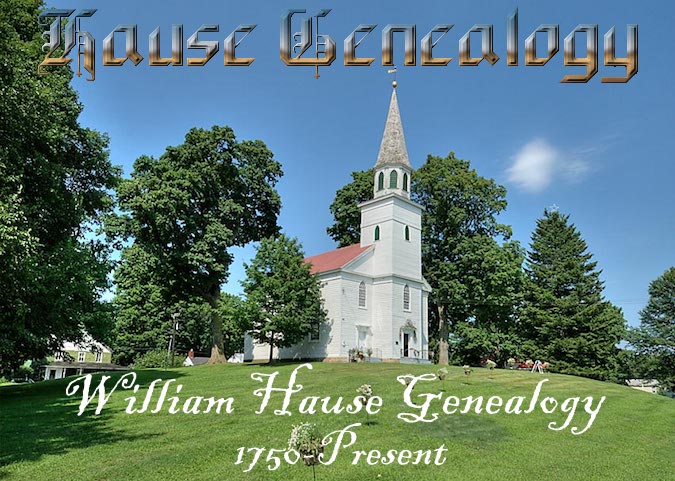
|
LITERARY SOURCES FOR THIS PAGE:
|
|
| Periodical
|
Image
|
|
|
| Title:
|
|
OCGS Newsletter
|
| Issue:
|
|
Vol. 4, #1; May 1974
|
| Article:
|
|
Southern Wisconsin Relatives of Bartholf, Smith, Beemer and Hawes
|
| Page:
|
|
5 (updated in Vol. 37, #3, July 2007, page 28, 29) |
|
|
|
|
SOURCE: Orange County Genealogy Society, 101 Main St, Goshen, New York 10924 (http://www.ocgsny.org/)
|
- "Southern Wisconsin Relatives of Bartholf, Smith, Beemer and Hawes;" Orange County Genealogical Society Quarterly, Goshen, NY: May 1974. Vol. 4, Iss. 1.
- Research by Charles R. Hause (24 Nov 1913 - 30 Mar 2002): 532 Lange Court, Libertyville, IL. 60048, or: 1216 Charles Dr., Shawnee, OK. 74801 Dec. 18,1981; Read a 1969 letter from Charles tracing William Hause here.
- Research by Mrs. Alberta Spaid Reeder (1871 - 27 Oct 1954), the great-granddaughter of Electa Ann Hause Williams (3 Jan 1801 - 24 Aug 1869). Alberta was born in Fayette, Seneca, New York and married William Henry Reeder (1868-1955). She died in 1954 in Geneva, New York.
- Research by Mrs. Josephine Gregory (30 Apr 1920 - 9 Feb 2013): 500 S Los Robles #320, Pasadena, CA. 91101; She based her work on the work of Alberta Reeder.
- Research by genealogists Kirk Moulton and Dan Kinsey, working on the Secord and Simon Haas families
- Calendar of N. Y. Colonial Manuscripts—Indorsed Land Papers; in the Office of the Secretary of State of New York. 1643-1803. Publication date 1864; Publisher Albany : Weed, Parsons & Co. Collection: University of Pittsburgh; Americana. Contributor: University of Pittsburgh Library System; Volume L, page 2, 31 December 1790. (https://archive.org/details/calendarofnycolo00alba/page/834/mode/2up) page 835.
- Tuxedo Park Library: 227 Route 17, Tuxedo Park, NY 10987 | Phone: 845-351-2207 | FAX: 845-351-2213 | Email: tuxpl@rcls.org.
- New York in the Revolution as Colony and State, Vol. 1 & 2 (Vol. 1) Albany, New York: Weed-Parsons Printing Company, Albany, New York, 1897. (Vol. 2) JB Lyon Company, Printers. Albany, NY. 1904. These two volumes are invaluable to researchers, because about two-thirds of New York's war records were destroyed by a fire at the Comptroller's Office in 1911. So the only documentation available for many muster rolls, etc., are in these books, which were compiled before the fire.
- House Family of the Mohawk, by Melvin Rhodes Shaver. St. Johnsville: Enterprise, 1942.
- Notes from Cornell collection 1072.
- People of the Valleys Revisited: History of Warwick, New York, 1700-2005, by Richard W Hull, Royal Fireworks Press, 2005.
- The Colonial Laws of New York from the Year 1664 to the Revolution, by James B. Lyon. Albany, New York, 1894: Chapter 1, pages 49 and 50.
- Laws of the State of New-York, Vol. 1 [1777-1784], (Albany, 1886); Session 2, Ch 16, pp. 102-109. An Act for raising Monies by Tax, to be applied towards the public Exigencies of the State: "...it is necessary in order to defray the expence of the present war, to discharge the debts due from this State, and to make due provision for the support of the civil government thereof, that monies should be raised within the same by tax." Real and personal property taxed. Improved real property was taxed at 1 shilling per pound and personal property was taxed at 6d [pence] per pound. Assessments were to be completed by the first Tuesday in April 1779 (12 April) [p. 104]. Copies of the assessment lists were to be filed with the county and state treasurers [p. 105]. The lists were to contain the name of the person, the amount of the tax laid for the personal estate at 6d [pence] per pound and 1 shilling per pound value of land. [p. 105]
- Witness To the Early American Experience, military map by creator Erskine, Robert (1735-1780). Title: "Roads from Newborough to Fort Lee. No 36" / by Robert Erskine F.R.S. Geogr. A. U.S. and Assistants. Genre/form:Early works to 1800 -- lcsh; format: 129.0 cm. wide by 85.0 cm.high, 1 map on 9 assembled sheets. Description: Military topographic map. Covers Orange and Rockland Counties in New York and Bergen, Passaic, Morris and Essex Counties in New Jersey. Shows roads, buildings and owners' names, also landforms, wetlands and streams. Shows relief by hachures; identifier: 004754_004747_004644; provenance: New-York Historical Society
- The Revolutionary War in Hackensack Valley: the Jersey Dutch and Neutral Ground, 1775-1783, by Leiby, Adrian C. Publisher: Rutgers Univ Press, New Brunswick. 1962
- A Dirty, Trifling, Piece of Business: The Revolutionary War as waged from Canada in 1781, by Gavin K. Watt, James F. Morrison, William A. Smy. Dundurn Press Ltd., 2009. Pawling's Levies, page 115.
- History of Rockland County, New York, by Frank Bertangue Green. New York: A.S. Barnes, 1886. William Hause appears on pages 38 and 58. Information on the "Gore Line" appears on pages 22-27. (E-book)
- History of Orange County with an Enumeration of Names of its Towns, Villages, Rivers, Creeks, Lakes, Ponds, Mountains, Hills and Other Known Localities, and their Etymologies or Historical Reasons Therefor; Together With Local Traditions And Short Biographical Sketches of Early Settlers, Etc. By Sam'l W. Eager, Esq., Member of the Historical Association of Newburgh, and Corresponding Member of the Historical Society Of the State of New York. Newburgh: S. T. Callahan, 1846-7.
- History of Steuben county, New York, with illustrations and biographical sketches of some of its prominent men and pioneers, by Prof. W. W. Clayton. Published 1879 by Lewis, Peck & co. in Philadelphia. Page 428 (Joseph Hause, Wayne collector, 1818).
- The Family of Hay: A History of the Progenitors of Col. Ann Hawkes Hay with Collateral Genealogies, A. D. 500 - 1908, by Charles J. Colcock, C. E. Privately printed for the author by the Genealogical Association, New York, 1908. Reprinted with Later Lines Added by Mrs. T. D. Bateman (Erroldine Hay) 1959.
- The Loyalists at the Battle of Fort Ninety Six, by Bobby Gilmer Moss. Scotia-Hibernia Press, South Carolina, 1999. Page 58.
- Public Papers of George Clinton, First Governor of New York, 1777-1795, 1801, Vol. 7, by George Clinton, New York (State). State Historian, Hugh Hastings, James Austin Holden. Published by the State of New York, 1904. Page 526: Col. Hay complains to Governor Clinton of Lt. Col Cooper's insubordination, Dec 28, 1780. "What am I to do with such an officer as will not obey orders! If I arrest him it may prolong the Business, and leave him intirely at his Ease..."
- Dragoon Diary, by C. F. William Maurer. Published by AuthorHouse. 2005. Pages 86, 87
- New York State Archives: New Jersey Gore Maps; Albany, NY; William's property is on maps 166 and 390A, beside the Ketcham and Sandford families. Also notes that "For the fieldbook and grantees see file "Southern Counties." If you look closey at the writing on the map, it reads, "Deeded 9th Jan. 1801." The dotted line signifies a "rode-way" running right through the middle. State Archives: 222 Madison Avenue, Albany, NY 12230
- The Balloting Book, and Other Documents Relating to Military Bounty Lands, in the State of New York. Albany, NY; Packard & VanBenthuysen, 1825.
- Portrait and Biographical Record of Seneca and Schuyler Counties, New York, Chapman Publishing Company, 1895.
- Liber of Wills Transcribed from the Orange County, N.Y., Records - Rockland County Surrogate's Office. Nos. 1 - 39. Compiled by George H. Budke, 1921: "No. 202. Will. fol. 415. Muchael Weymer of Hempsted, D. May 24, 1810. P. Apr. 19, 1816. Weak in body, Son, Edward Weymer, The heirs of Jacob Weymer, The heirs of Michael Weymer, all my land in the Town of Monroe, Orange Co., N. Y., Son, George Weymer, all my right to a tract of land at the mill along the Ramapo river and sold by him with my consent to Salomon Townsend, The heirs of Mary Macmurtry, The heirs of Ann Bennet, Sons, James and John, to receive farm in Hempstead and any land granted by the State of New York, as I have a prospect of obtaining from the state some vacant land near the same, Grand daughter, Mary Ann Macmurtry. Executors: Garrest Sarven, Esq., and George I. Suffern." (The town of Monroe was named in 1808, but it's now part of Tuxedo.)
- Thomas Sanford, the Emigrant to New England; Ancestry, Life, and Descendants, 1632-4. Sketches of Four Other Pioneer Sanfords and some of their Descendants, Volume: 1, by Carlton Elisha Sanford and Charles A Hoppin. Publisher: Rutland, Vt., The Tuttle Company, 1911; p. 158, 222, 223 (William Hause, Jr., and Esther Sanford), 371-2 (Jessie J Hause).
- Madison, Dane County and Surrounding Towns: Being a History and Guide to Places of Scenic Beauty and Historical Note ... Early Intercourse of the Settlers with the Indians ... with a Complete List of County Supervisors and Officers, and Legislative Members, published by W. J. Park & Company, 1877. 664 p.
- History of Dane County, Wisconsin ... preceded by a history of Wisconsin, statistics of the state, and an abstract of its laws and constitution and of the Constitution of the United States by Butterfield, Consul Willshire, 1824-1899; Published by the Western Historical Co., Chicago, 1880.
- History of San Bernardino and Riverside Counties: With Selected Biography of Actors and Witnesses of the Period of Growth and Achievement, by John Brown, James Boyd; Western Historical Association, Riverside County (Calif.), 1922. Page 1204: "Norman S. Hawes—This veteran soldier of the Union has been identified with the citizenship of Riverside more than thirty years, and the business which he founded here is still continued by one of his sons. Mr. Hawes was born at Reading, Hillsdale County, Michigan, October 28, 1842. His family name was written in the record of births as Hause, and it is said that when he was a boy of about fifteen he proposed to his father that they change the spelling to Hawes, which was done, though his uncles—and other members of the family still continue the old spelling. The record of the Hause family runs back to William Hause, who was born February 24, 1750. He married Martha Wood, who was born May 4, 1753, and died September 8, 1818."
- "To George Washington from the Orange County Committee of Safety", Haverstraw, NY, 16 Jul 1776; Founders Online, National Archives.
- "Washington slept in Tuxedo, too" by Deborah Harmon, Times Herald-Record, 40 Mulberry St., Middletown, NY 10940; Posted 06 Dec 2010.
- "Nyack People & Places: Skirmish Krew Relives Revolutionary War in Upper Nyack" by Mike Hayes, Nyack News & Views, Posted 21 May 2020.
- "2018 Town of Tuxedo Comprehensive Plan Update," an update to the September 2011 Comprehensive Plan Update, prepared by the Town Board of the Town of Tuxedo, New York with Technical Assistance Provided by Nelson, Pope, & Voorhis, LLC. Orange County, New York; April 2018. Pages 76-82: The Orange Turnpike, now New York State Route 17 (NY 17) extends for 397 miles through the Southern Tier and Downstate regions of New York. It begins at the Pennsylvania state line and follows the Southern Tier Expressway east through Corning to Woodbury, where it turns south to follow the Orange Turnpike, where it intersects with the eastern terminus of NY 17M. As the route heads southward from this junction, proceeds through a disjointed piece of Harriman State Park and enters the town of Tuxedo.
In 1714, what became the Town of Tuxedo was a part of the Precinct of Goshen. "Tuxedo" Lake, for which the Town is named, was historically known as Truxedo, or Duck Cedar Pond. Within the town, the Man-of-War Rock site was adjacent to Tuxedo Park cemetery, located directly east of the Ramapo River, adjacent to what was a north-south Indian trail on Route 17. William's property ran to the Man-of-War Rock on Highway 17. This area housed a handful of homes, farms and structures—during William's time, much of the land was forest land used to support the iron industry (until 1885 when it became Tuxedo Park). The discovery of iron in the Ramapo Mountains, containing magnetite with the highest known iron content, led speculators to establish mining and smelting facilities in Tuxedo during the mid-to-late 18th Century (a nasty business which isn't conducive to farming, and may have hastened the departure of the Hause and Wood families). NY 17 proceeds through a lightly populated area to the village of Tuxedo Park. The route continues on, paralleling the Thruway into Rockland County.
In 1800, the Orange Turnpike Association was formed, and until the NYS Thruway was completed in 1957, the Orange Turnpike—now Route 17—was the only major route to upstate New York.)
- "William House family, NY;" Orange County Genealogical Society Quarterly, Goshen, NY: May 1984. Vol. 14, Iss. 1.
- "Jonas Wood UEL;" by Hoople, Elizabeth (Glengarry Historical Society), Wood Research Team, 1984. Stormont, Dundas and Glengarry, Ont. 33 pages.
- Family historian Charles Hause, from 1963: "William Hause, Sr. was born in the Haverstraw area, which is now in Rockland county, New York. In his day this area had rather uncertain limits. He enlisted for the Revolutionary War, in the Orange County Militia (Haverstraw) under Colonel Ann Hawk Hay. In 1800, he applied for title to the farm on which he had been living for several years on the Orange Turnpike. The border dispute between New York and New Jersey having been settled by that time, he did receive title to it in 1802.He sold it a couple of weeks later to Hannah Weymer for 20¢ per acre. It had cost him 25¢ per acre to obtain title to it from the state. He was mentioned in a history of Orange county as a roadmaster. He must of had a section of the Orange Turnpike (which ran through his farm) to keep in condition during the Revolution. In 1809, he left for Seneca county and moved over to Hause Hill (still shown on the Schuyler county maps that way). This was in the township of Wayne, Steuben county, New York then. In April 1812 a meeting was held in the house of Joseph Hause to name the officials for the new township of Tyrone. Joseph's father William, Sr. was named Supt. of Roads. The reason for the meeting being held at Joseph's house was probably that at the time he ran an Inn on the Hill. 'A resting place for man and beast.' Hause Hill is between the village of Tyrone and Altay. In 1813, Cyrus Maynard arrived in Altay with the Kendall's. and William Sr. sold parcels of land to them. Lucinda Maynard was born here and later married Harris Elisha Hause. Nothing is known for certain of William Hause's parentage."
- History of Tioga, Chemung, Tompkins, and Schuyler Counties, New York. With Illustrations and Biographical Sketches of Some of Its Prominent Men and Pioneers; Philadelphis: Everts & Ensign, 1879, p. 683: "The Tyrone Baptist Church was constituted as the Baptist Church of Jersey by a council of delegates from four surrounding churches, met for that purpose at the house of David Hight, in what was then the town of Jersey, Nov. 22, 1815... Phineas Fullerton was licensed to preach, and supplied part of the time for a few years ; but he became intemperate, and in 1818 was excluded." The church records were lost to a fire in 1851.
- Steuben County Wills: "Barney T. Spear (SIC) age 78 - date of will, Aug. 21, 1854. Date of probate: Feb. 29, 1864, Tryone, Steuben Co., NY. His wife Sally, son Henry, son Tunis, son John. Daughter Charity. Exec. Son Jacob, dau. Elizabeth Reynolds, and dau. Polly House, wit I. H. Hill & Wayne Boorom, both of Tyrone."
- Research by Bob and Shirley Hause, of Kansas. Bob is descended through William Hause, Jr. He holds letters written by his cousin, Charles Hause, from 1969, along with genealogical work done at that time. Bob has continued the work of Charles.
- The Family of Samuel Hawes, Volumes 1-12, compiled and written by Derek A. Foxley: Rixeyville, Virginia; Version 1.0 — June 2018: This family history sources the William Hawes Family Lines Collection, 1750-1876, three typewritten pages from approx. 1935, supplied by Holly Allred (photocopies held by Derek Foxley, Rixeyville, Virginia, United States, 2017).
Explanation of Source: The supplier's family believes the original source of the 3 type-written pages of the William Hawes Family Lines Collection, 1750-1876 to be from family records or even a Family Bible of Matthew Hawes however, this has not been verified. The location of the original is currently unknown.
Chain of Custody of Source: Holly Allred received the 3 type-written papers of the William Hawes Family Lines Collection, 1750-1876, from her mother, Beverley Lundstrom, who received it from her cousin Maxine Hofmann. Maxine typed the documents we currently have as part of her genealogical work. Maxine probably got the information from her grandmother, Jennie Rosetta Hawes, as it is known that Maxine did interview and collect genealogical information from Jennie some time prior to Jennie's death in 1935. Jennie in turn would have received it from her father, Warren Nicholas, who would have got it from his father, Matthew Hawes.
Validation of Source: This information from the William Hawes Family Lines Collection, 1750-1876, from Holly Allred has been validated by Derek Foxley for the family of Samuel Hawes. The names and dates given in the Collection concerning Samuel Hawes and his children could not have been a product of research as it contains information that would not have been available, or at best very, very difficult to research pre-1935—and which has been hard to find even in 2014-2017. Three examples 1) it includes the name and birthdate of Silas Hawes whose records linking him to Samuel Hawes are in Argentina, in Spanish. 2) It also includes the name and birthdate of Luman (Lyman?) Hawes, whose only record in 2017 is one reference in a Civil War roster. 3) It also lists Albert Hawes, who has no documented link to Samuel, but whose ancestors have proven the descendance through Y-DNA testing. At least for Samuel Hawes line, the Collection can only be a product of family held records passed down over the generations as it contains information hidden from researchers.
|

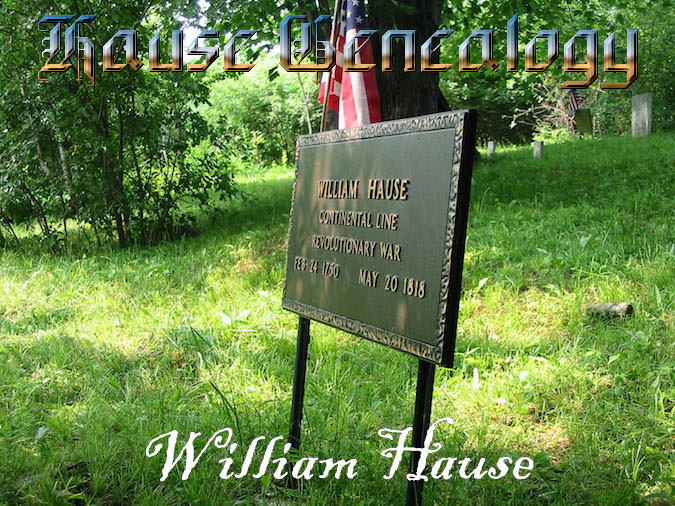



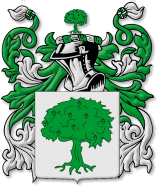







 The Hudson River was of vital importance to both sides during the conflict. During the American Revolution, Rockland became an important crossroads—a crucial link between the Northern and Southern colonies. There were American fortifications at Sidman's Fort at Suffern, a blockhouse at Palisades, and larger forts at Stony Point, Bear Mountain and Fort Montgomery. Entire armies and vital supplies passed through Rockland on their way to war. The British hoped to control the river and divide the Colonies, as well as speed the communication between their armies in Canada and lower New York. So the rebel militia set up obstructions in the water, including "fire-ships," booms, and cheveaux-de-frise (made by sinking cribs of timber across the channel), to impede British ships. Large iron chains, almost two thousand feet across, were stretched underwater at several points that the rebels could pull tight. But the British eventually smashed their way through all of the obstructions, and it was up to the militia to halt their progress.
The Hudson River was of vital importance to both sides during the conflict. During the American Revolution, Rockland became an important crossroads—a crucial link between the Northern and Southern colonies. There were American fortifications at Sidman's Fort at Suffern, a blockhouse at Palisades, and larger forts at Stony Point, Bear Mountain and Fort Montgomery. Entire armies and vital supplies passed through Rockland on their way to war. The British hoped to control the river and divide the Colonies, as well as speed the communication between their armies in Canada and lower New York. So the rebel militia set up obstructions in the water, including "fire-ships," booms, and cheveaux-de-frise (made by sinking cribs of timber across the channel), to impede British ships. Large iron chains, almost two thousand feet across, were stretched underwater at several points that the rebels could pull tight. But the British eventually smashed their way through all of the obstructions, and it was up to the militia to halt their progress.
